Patrick Scalisi's Blog
October 13, 2023
Connecticut Cryptids is Now Available!

For the past three years, I've been working on a non-fiction local history project about Connecticut cryptids -- that is, creatures that are thought to exist but never proven to exist.
How can stories about Bigfoot and sea serpents be non-fiction, you ask? Because many have roots in real local history and folklore! Working with my creative partner, Valerie Ruby-Omen, we have created what we believe to be the definitive guide to Connecticut cryptids.
Published on Friday, Oct. 13 (mwahahaha!), the title is now available for purchase wherever books are sold!
GET IT ON AMAZON
GET IT AT B&N
OR ORDER THROUGH YOUR LOCAL INDEPENDENT BOOKSTORE USING ISBN 979-8218244682.
Published on October 13, 2023 14:41
•
Tags:
connecticut-cryptids, cryptid, cryptids, cryptozoologist, cryptozoology, ct-cryptids, local-history, new-book
October 8, 2020
The Essential Mandalore Episodes of Star Wars: Rebels

My being put off by the animated Clone Wars series meant that I was an extreme latecomer to Star Wars: Rebels. The show had long ended by the time I started watching in 2020.
But as I watched the first season of The Mandalorian and began to dive into the Mandalore-specific episodes of Clone Wars, it became clear that Rebels would also have an important bearing on the overall narrative.
Beyond that, though, Rebels is a genuinely good show. I was hooked from the first narrative arc, namely when Jedi-in-exile Kanan Jarrus says to the young Ezra Bridger, “Kid, I’m about to let everyone in on a secret” and takes out his lightsaber for the first time.
In crafting this show, it’s clear that Dave Filoni had matured as a storyteller and showrunner. The episodes often deal with complex themes related to war, family, and loss, and they eschew the more childish elements that initially soured me on Clone Wars.
Much as I did in my other blog entry, this post will serve as a primer on the essential episodes needed to best understand the events leading up to The Mandalorian.
Really, though, I would encourage readers to watch Rebels in its entirety. For one thing, it’s shorter than Clone Wars by almost half. For another, it has a Mandalorian as one of its main characters: the young warrior Sabine Wren.
Here is the episode list, followed by recaps and analysis. Note that after the list are spoilers! I would also strongly recommend reading the Clone Wars Mandalore primer first.
Season 2: Episodes 8, 13, 21-22
Graphic Novel - Star Wars: Kanan Omnibus*
Solo: A Star Wars Story*
Season 3: Episodes 3, 7, 11, 15-16, 20-22
Season 4: Episodes 1-2
* = optional
---
S2E8: “Blood Sisters”
Much like Clone Wars, there are no season 1 episodes of Rebels dealing with Mandalore, and this one is only somewhat related.
On the planet Garel, Sabine and Ezra are sent on a mission to rendezvous with a mysterious courier who has something vital for the rebel cause. They aren’t the only ones looking for the courier, though. A bounty hunter named Ketsu Onyo is also on the hunt for the rebel informant.
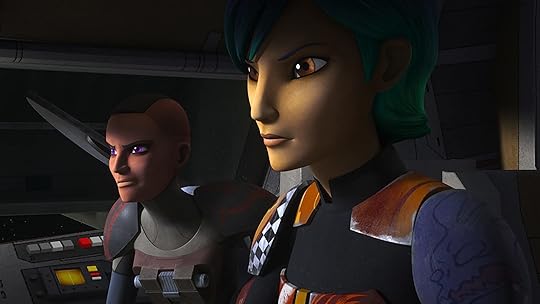
Ketsu and Sabine have history, and this is the important part of the episode. Ketsu and Sabine escaped together from the Imperial Academy on Mandalore. Afterwards, they became bounty hunters and even had plans to join the Black Sun crime syndicate. But things didn’t go exactly to plan when Ketsu double-crossed Sabine.
By the end of the episode, Ketsu and Sabine have mended their friendship, and Ketsu even considers helping the rebellion. Moreover, the back story we glean about Sabine serves as essential building blocks of her character.
S2E13: “The Protector of Concord Dawn”
Finally, a true Mandalore episode!
The rebels are looking for a new hyperspace route and decide to ask for assistance from the Mandalorian sect living on the planet Concord Dawn. Although Mandalore was officially neutral during the Clone Wars, this sect, known as the Protectors, helped train clone troopers for the Republic. Their leader, Fenn Rau, also engaged in several battles against the separatists.
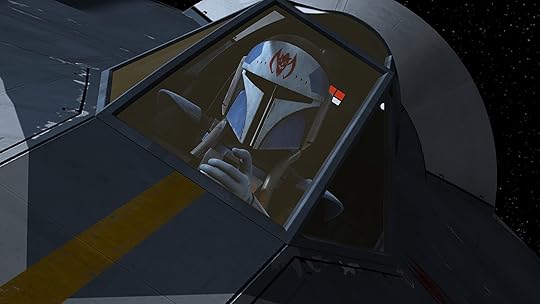
After the rise of Emperor Palpatine, Concord Dawn began trading favors with the Empire in exchange for its independence. This means that the rebels aren’t exactly welcome when they come to negotiate passage. Rebel leader Hera Syndulla and her squad are gunned down by Rau, with Hera suffering serious injuries. When Kanan and Sabine return to Concord Dawn to finish the job, we learn a lot of critical information:
1.) Sabine’s last name refers to her clan, Clan Wren, which is part of House Vizsla. If the name “Vizsla” sounds familiar, it’s because it featured heavily in Clone Wars. Tarre Vizsla was the first Mandalorian ever admitted to the Jedi Academy, and he wielded a unique black-blade lightsaber known as the Darksaber. The Darksaber became an heirloom in House Vizsla, later held by Tarre’s descendant, Pre Vizsla of the Death Watch sect.
2.) Since Clan Wren is part of House Vizsla, it was also a member of Death Watch. During the Clone Wars, Pre Vizsla and Death Watch tried to overthrow Mandalore with the help of Darth Maul. After Maul killed Pre Vizsla in single combat, Death Watch split in two factions: those loyal to Maul and those who followed Bo-Katan Kryze. Maul led his faction with the Darksaber he claimed from Pre Vizsla.
3.) The Protectors took part in the Mandalorian Civil War prior to the rule of Duchess Satine Kryze. Though it’s not clear yet which side the Protectors fought on, we can theorize that they supported the pacifist government since they view Death Watch as traitors.
As we go through Rebels, there are two threads we need to pursue. The first thread follows the Darksaber (and Maul) while the second follows the events on Mandalore leading up to the so-called Great Purge. This way we can see how things got to be the way they are by the time we reach The Mandalorian.
In “The Protector of Concord Dawn” we get crucial data on both. By the end of the episode, Kanan and Sabine have taken Fenn Rau as a kind of political prisoner, ensuring that the rebels can use the hyperspace corridor near Concord Dawn for the foreseeable future.
Graphic Novel - Star Wars: Kanan Omnibus
This graphic novel is strictly optional and doesn't add anything of huge value to the Mandalore storyline. In fact, it's about Kanan's backstory and takes place sometime before the end of Rebels season 2.
The only reason I'm including it here is because of its ties to "The Protector of Concord Dawn." There's a brief scene in the episode where Kanan and Fenn Rau discuss the Battle of Mygeeto. You can see this incident in the Kanan graphic novel, though it's scarcely two pages long.
Like most of Rebels, I recommend this comic because it tells a good story. But it admittedly has very little bearing on Mandalore.
Film – Solo: A Star Wars Story

Right now you’re asking yourself: What does Solo: A Star Wars Story have to do with Rebels?
The honest answer is: not much. Solo is also optional, but I’m including it here for a very specific reason.
Since the Clone Wars animated series, the fate of Mandalore and the Darksaber are inextricably tied to Darth Maul. After Maul’s escape from Ahsoka Tano in the final season of Clone Wars, the former Sith returns to his criminal enterprises, at one point ascending to lead the Crimson Dawn crime syndicate. Maul’s cameo in Solo provides connective tissue to his whereabouts between Clone Wars and his first appearance in Rebels at the end of season 2.
Notably, Maul has the Darksaber at the end of the Son of Dathomir graphic novel, but does not wield it in the final episodes of Clone Wars or in Solo. Hmmm …
S2E21-22: “Twilight of the Apprentice Part 1 & 2”
The spectacular season 2 finale of Rebels sees the return of a who’s who of famous Star Wars characters. Ahsoka! The Inquisitors! Darth Maul! Darth Vader! It’s pretty much a fan’s dream come true, with several explosive confrontations taking place.
For the purposes of this primer, Maul’s appearance in these episodes is what makes them essential.

Sometime after the events in Solo, Maul journeys to Malachor in search of a Sith holocron. Maul tells Ezra that he has been stranded on Malachor for some time, though we never learn if this is true or a deception. We also learn that the Inquisitors aren’t just hunting Jedi — they’ve also been tracking Maul for years as a “shadow” threat to the Emperor’s rule.
Not unexpectedly, Maul tries to manipulate the young Ezra. Double-crosses occur. By the end of the episode, several of the Inquisitors are dead, Maul has blinded Kanan, and Ahsoka receives confirmation that Anakin Skywalker and Darth Vader are one and the same. Their duel leaves Ahsoka missing in action … for now.
Once again, Maul does not wield the Darksaber.
S3E3: “The Holocrons of Fate”
Just three episodes into season 3 and Maul is back. He’s taken the crew of the Ghost hostage and wants the Sith holocron from Malachor in exchange for their lives.
During the hostage standoff, Maul quips to Sabine that she above all should trust him, since he once ruled Mandalore. Her shipmates ask if this is true, and Sabine says that it is.
When Maul finally gets access to the Sith holocron, he unites it with Kanan’s Jedi holocron to gain greater enlightenment. What he learns instead (thought it is not explicitly stated) is that his old nemesis Obi-Wan Kenobi has survived the Jedi purge and is still alive somewhere in the galaxy.
S3E7: “Imperial Supercommandos”
Early in this episode, Ezra exclaims, “I really don’t get this whole Mandalorian thing.” Well buckle in friends, because things are about to move forward at hyperspeed.
The episode begins with Sabine playing a strategy game with Fenn Rau. Rau accuses Sabine of being a traitor. Sabine tries to recruit Rau to the rebel cause.

Before long, Sabine and Rau are summoned to the war room. There’s a problem — the rebels have lost contact with the Mandalorians living on Concord Dawn. Suspecting some kind of trap, Sabine, Ezra, and Rau travel there to investigate.
Upon arrival, the trio discovers that the Protectors have been wiped out. The evidence, though, suggests that the attack came from other Mandalorians. This turns out to be only partly right. The base was attacked by other Mandalorians but not because of some inter-clan feud. As Sabine, Ezra, and Rau come to learn, the Protectors were killed by Mandalorians in service to the Empire. Leading these so-called “supercommandos” is Gar Saxon, who announces himself as the imperial viceroy of Mandalore.
This is where we need to take a step back into the Clone Wars era, specifically the Son of Dathomir graphic novel and the animated show’s final season. Saxon was a small but important side character in these stories before stepping fully into the spotlight. It was Saxon who led a group of Mandalorian commandos to free Darth Maul from the Emperor’s prison on Stygeon Prime. It was also Saxon who served as Maul’s commander in the battles that followed.
Saxon’s most defining trait is that he’ll back anyone who will help him advance his own self-interest. Initially a supporter of Prime Minister Almec, Saxon later assassinated Mandalore’s puppet ruler on Maul’s orders. And when Maul betrayed Saxon at the end of the Clone Wars, Saxon was quick to align himself with the emerging Empire. This allegiance apparently put him on the fast track to becoming Mandalore’s governor under the auspices of the Emperor.
Back on Concord Dawn, we learn that Clan Saxon — like Clan Wren — is a member of House Vizsla. Though we never get confirmation that Clan Saxon was a member of Death Watch, it’s not outside the realm of possibility. We also learn that the Protectors were aligned with the throne of Mandalore, confirming which side they fought on during the Mandalorian Civil War.
Perhaps the biggest reveal, though, is about Sabine’s mother, Ursa Wren, whom Saxon says is now serving the Empire. Ursa appeared with Bo-Katan briefly in the final episodes of Clone Wars as a member of the Death Watch splinter group that broke away from Darth Maul. To hear that Ursa is now serving the Empire is indeed shocking.
After fleeing the planet to save his own skin, Rau has a change of heart and comes back to rescue Sabine and Ezra. Once they have defeated Saxon’s men and made their escape, Rau recognizes that Sabine has not forgotten the ways of her people and agrees to join the rebellion.
S3E11: “Visions and Voices”
At first, this episode doesn’t seem to have much relevance to Mandalore apart from an appearance by Darth Maul. But the second half of “Visions and Voices” is where things take another major leap forward.
At the rebel base on Atollon, Ezra begins having visions of Maul from their being joined by the holocrons in episode 3. Kanan takes Ezra to see the Force-sensitive being Bendu, but it isn’t long before they are confronted by Maul in the flesh. In exchange for keeping the location of the rebel base secret, Maul wants to join with Ezra again to finally get the answers he’s been seeking.
Ezra reluctantly agrees, and the two travel to Maul’s home planet of Dathomir followed covertly by Kanan and Sabine. Maul leads Ezra into the former lair of the Nightsisters, which he has been using as a kind of home base / shrine. It is full of what Maul calls “artifacts from my past,” and it is here that Ezra makes an amazing discovery. Situated beneath a Picasso-esque painting of Duchess Satine Kryze of Mandalore is — drum roll please — the Darksaber.

Let’s take a moment to unpack this. First, this episode provides an answer to where the Darksaber has been since its last appearance in the Son of Dathomir graphic novel. Maul has apparently been keeping it stashed on his homeworld, though we don’t know why he chose to use his red lightsaber over the Darksaber. Equally unclear is why the Darksaber is enshrined beneath a portrait of Duchess Satine. After all, Maul killed the duchess with the weapon way back in season 5 of Clone Wars.
Ezra asks Maul if the Darksaber is a kind of lightsaber. Maul chuckles and replies, “Yes, but not like any that you would know. If your Mandalorian friend was here, she could explain it to you.” He then insists that he and Ezra get on with the ritual that will unite their minds.
To accomplish this, Maul is going to leverage Nightsister magic. What Maul fails to mention is that the use of such magic comes at a cost, namely that the spirits of fallen Nightsisters will want to merge with living hosts. Kanan and Sabine arrive just in time to provide two warm bodies.
A fight ensues in which Ezra is forced to combat his friends. Maul asks Ezra to officially become his apprentice, but Ezra refuses. Maul flees in disgust, leaving Ezra to find a way to save Kanan and Sabine. We see the Darksaber in action when a possessed Sabine wields it against Ezra.
Eventually, Ezra destroys the Nightsisters’ altar, which drives away the spirits. Neither Kanan nor Sabine remember being possessed. Before leaving the planet, Sabine spots the Darksaber on the ground and, intrigued, takes it with her.
S3E15: “Trials of the Darksaber”
This episode is purely optional. Just kidding — it has “Darksaber” in the title for goodness sake!
The story begins with Kanan showing the Darksaber to Fenn Rau. Rau then gives a brief history of the Darksaber and its symbolic meaning, which is so perfect that it defies summary. Instead, here’s the full clip from Disney XD.
Kanan and Rau proceed to ask Sabine if she’ll take the Darksaber. She is, after all, a legitimate claimant to the blade since Clan Wren is a member of House Vizsla. However, Sabine also knows what wielding the Darksaber entails and is reluctant for several reasons. For one thing, she’s estranged from her biological family and has found a new family in the crew of the Ghost. For another, it would require her to take a precarious leadership role that she’s not sure she’s ready for.
In the end, Sabine agrees to begin working with the blade. What follows is, for Star Wars, a fairly typical training sequence. Sabine struggles, reaches a point of crisis, and returns recommitted. In all honesty, this episode would be fairly paint-by-numbers if not for the important subject matter we’ve been following. And we do get to see the Darksaber in action again, so there’s that.

S3E16: “Legacy of Mandalore”
This episode is a direct continuation of the previous one. Kanan, Ezra, Fenn Rau, and Sabine travel to Krownest, a planet governed by Mandalore that serves as the ancestral home of Clan Wren.
At this point, we know a bit about how Mandalorian culture is organized. The smallest unit seems to be extended families or clans, which are organized into houses. Multiple clans make up a house, and houses themselves seem to draw their names from clans. This means that there is “Clan Vizsla” (the family) and “House Vizsla” (a collection of clans that make up the house). There are also groups, which I call sects, that can be made up of multiple clans or families. These include groups like Death Watch or the Protectors.
This leads to an interesting question: Do all clans, which are essentially the smallest unit of Mandalorian society, rule an entire planet? Or is it only certain elevated clans, a la Dune? The former is possible given that the so-called Mandalore sector is made up of nearly 1,000 worlds according to Wookieepedia.
In any case, Sabine receives the exact kind of reception that she expected upon her return home. Her family isn’t happy to see her and only agrees to postpone her arrest when Sabine shows them the Darksaber.
At this point, we are properly introduced to Sabine’s mother, Ursa, and her brother, Tristan. Tristan is working for Gar Saxon as a supercommando in order to rehabilitate Clan Wren’s standing after Sabine defected from the Empire.
Ursa and Sabine argue, as mothers and daughters are wont to do, before coming to an impasse. Ursa asserts that Sabine doesn’t have a right to the Darksaber since she didn’t win it from Maul in combat. Sabine also learns that her father is imprisoned on Mandalore as leverage for keeping Clan Wren in line.
While Sabine and Tristan do a bit of sparring for old time’s sake, Ursa has a secret meeting with Saxon. She agrees to hand over Kanan, Ezra, and the Darksaber in exchange for her daughter’s life. That’s about when all hell breaks loose. Ursa’s own betrayal is turned on its head when Saxon orders Clan Wren eliminated.

Now facing the death of their whole family, Ursa and Tristan fight on the side of the rebels against Saxon’s supercommandos. This faceoff culminates in a duel between Saxon, wielding the Darksaber, and Sabine, fighting with Ezra’s lightsaber. Let me just say that this moment is one to rival some in the films. John Williams’ classic theme soars as Sabine and Saxon battle across an ice lake. Sabine defeats her opponent to legitimately win back the Darksaber but refuses to kill Saxon outright. This is handled by Tristan, who shoots Saxon in the chest as he lunges at Sabine’s back.
As the episode comes to a close, Sabine decides to stay with her family for a while to try and rally the Mandalorians against the Empire. For now, at least, she’s leaving the crew of the Ghost.
S3E20: “Twin Suns”
As I mentioned earlier, the fate of Mandalore and the Darksaber has been inextricably tied to Darth Maul since the period of the Clone Wars. So while this episode doesn’t have anything to do specifically with Mandalore, it does close out one of the threads we’ve been following. It’s also considered one of the very best episodes in all of Rebels.
On Atollon, things are gearing up for the rebel assault on Lothal, but Ezra is once again having visions. He hears the voices of both Maul and Obi-Wan Kenobi calling out to him and becomes convinced that he must seek out Obi-Wan to aid the rebel cause.
Of course, Hera is reluctant to let Ezra go because he’s needed for the upcoming battle. But Ezra, being the headstrong young Jedi that he is, sneaks into a shuttle and makes straight for Tatooine.
Once there, Ezra is attacked by Tusken Raiders and his ship destroyed. He wanders aimlessly into the desert in search of Obi-Wan, only to be further beset by sandstorms and thirst. At the end of his strength, he finally collapses on the hardpan.
When Ezra awakes, he has been found by Obi-Wan — exactly as Maul planned. The former Sith appears out of the dark desert to challenge his old foe. Obi-Wan sends Ezra on his way before squaring off against Maul.
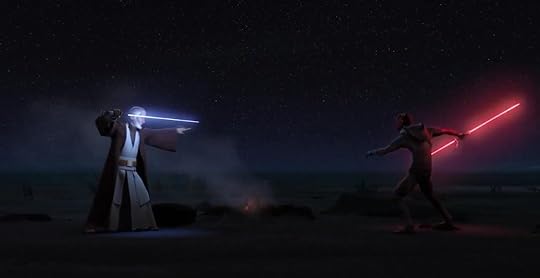
What follows isn’t the epic duel that you might have been expecting in the lead up to this confrontation. On the contrary, the fight between Maul and Obi-Wan is short and quiet, with Obi-Wan dealing a killing blow almost at once. It could almost be considered anticlimactic if not for how bombastic Maul has become in his rage and near-madness. In this regard, the circumstances of Maul’s death seem almost appropriate. Obi-Wan cradles his one-time nemesis before closing his eyes for good.
And with that, Maul’s part in the story of Mandalore and the Darksaber comes to a close. The point of Sabine never having won the Darksaber from Maul is made moot, especially since she bested Gar Saxon in single combat to reclaim the blade. Furthermore, we won’t have to wait very long for the Mandalore thread to continue.
S3E21-22: “Zero Hour Part 1 & 2”
The assault on Lothal is endangered when Imperial Agent Kallus is finally outed as a rebel spy by Grand Admiral Thrawn. Eager to strike a crushing blow against the rebellion, Thrawn orders an attack on the newly discovered base on Atollon.
With an imperial blockade surrounding the planet, including an interdictor that prevents hyperspace travel, the rebels expend terrible resources to make an opening for Ezra to escape in Maul’s old ship. While the remaining rebel fighters go to ground on Atollon, Ezra is charged with finding reinforcements. And who better to ask than a certain Mandalorian who exited the crew of the Ghost just a few episodes prior?
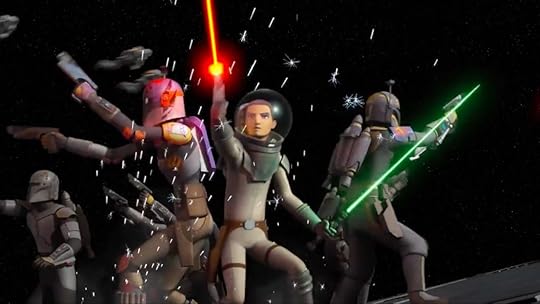
Returning to Krownest, Ezra beseeches Ursa, Sabine, and Tristan for help. It is here that we learn that Clan Wren is now locked in a civil conflict with Clan Saxon. It’s unclear yet how much of Mandalore has been consumed by this conflict, but Ursa Wren is reluctant to grant Ezra any troops. Sabine, however, insists on helping her friends and is given permission to go with whatever volunteers she can round up.
There’s no need to summarize the battle that follows, except to say that the Mandalorian reinforcements from Clan Wren succeed in damaging the interdictor enough for the rebels to escape. As we close out the third season of the show, Ezra and friends are on route to Yavin with a few new allies.
S4E1-2: “Heroes of Mandalore Part 1 & 2”
In exchange for helping the rebels escape Atollon, Kanan and Ezra open the fourth and final season of Rebels repaying the favor for their Mandalorian allies. Specifically, they’re on a mission to free Sabine’s father, who is scheduled for execution.
Mandalore is now in the midst of a second, full-blown civil war as Clan Wren and its allies struggle against the clans aligned with the Empire. Leading the imperials is Gar Saxon’s brother, Tiber, who assumed governorship of Mandalore after Gar’s death. Tiber Saxon is, somehow, even more ruthless than his brother. He completely buys into the imperial cause to the extent that he is willing to sacrifice his own Mandalorian heritage in the pursuit of power.
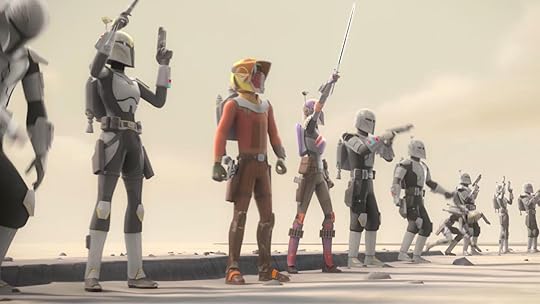
Helping Tiber achieve his goals is a new weapon that we’ve heard whispers about for almost two seasons of the show. Sabine has mentioned several times that one of the reasons she left the Imperial Academy was because she had developed a weapon that was meant to be used against her own people. We didn’t know anything else about this weapon — until now.
In “Heroes of Mandalore” we finally meet The Duchess, a modified walker than can specifically target Mandalorian beskar armor without inflicting damage to anything else around it. In effect, The Duchess can fry Mandalorian warriors while safely bypassing stormtroopers.
In the first part of this duology, Sabine, wielding the Darksaber, leads an unsuccessful strike to rescue her father. She is aided at the last minute by Clan Kryze, led by Bo-Katan in her first appearance in Rebels. We learn that Bo-Katan briefly served as regent of Mandalore at the end of the Clone Wars but was deposed by Clan Saxon when Bo-Katan refused to recognize imperial rule.
Before long, the group receives intel that Sabine’s father is being transported to the capital. With Bo-Katan’s help, they launch a new rescue against the prisoner convoy and succeed in freeing Alrich Wren.
In part 2, Sabine finally has to face the consequences of her role in creating The Duchess years ago. The clans she has rallied to her cause are justifiably angry that Sabine had a hand in making a weapon that could wipe out her people. Bo-Katan reassures everyone that Sabine has not only realized the gravity of her mistake, but is also willing to risk her life to undo the damage.
The rebels launch a two-prong assault on Tiber Saxon’s star destroyer, where The Duchess is being held. Half the team is tasked with erasing all records of the weapon while the other half destroys the existing prototype.
Sabine and Bo-Katan are almost captured before turning the tables on Tiber. Sabine modifies The Duchess to target stormtrooper armor instead of beskar armor and is tempted to take possession of the weapon for the rebels’ fight against the Empire. But Bo-Katan sees where this path will lead and urges Sabine to make the honorable decision and destroy The Duchess once and for all.
When Clan Wren returns to base, they find that warriors from several other clans have chosen to join their cause. Sabine, having seen Bo-Katan’s natural wisdom and leadership during the assault, urges Clan Kryze to take possession of the Darksaber. Bo-Katan agrees to wield the weapon in her sister’s memory as the clans opposed to the Empire fight to reunite Mandalore once and for all.

---
Even though we’ve come to the end of our list, there are a few unanswered questions that have not yet been addressed by the current Star Wars canon.
First, we leave the story of the Darksaber with Bo-Katan during the height of the second Mandalorian civil war. This takes place approximately two years before the Battle of Yavin. The Darksaber next appears at the end of season 1 of The Mandalorian, which takes place approximately nine years after the Battle of Yavin. That gives us a span of 11 years in which we know nothing about its whereabouts.
Another thing we know relatively little about is the Great Purge of Mandalore. This event is referenced several times during season 1 of The Mandalorian, but we don’t have many details. All we know is that it took place sometime during the span of 11 years between the second Mandalorian civil war and the fall of the Empire. Did Bo-Katan win the civil war on the side of Mandalore only to have the Empire respond with terrible retribution? Did the Empire punish Mandalore for being aligned with the Rebel Alliance? We don’t know. With Katee Stackhoff having been cast as the live-action Bo-Katan in season 2 of The Mandalorian (she also voiced the animated character), there’s the possibility we’ll get answers soon.
Finally, we know from the series finale of Rebels that Sabine Wren survived both the Great Purge and the Galactic Civil War. Did she survive the purge because she was fighting with the Rebel Alliance and wasn’t on Mandalore? Again, we don’t know. If Bo-Katan and Ahsoka appear in future episodes of The Mandalorian, it’s not outside the possibility that Sabine may show up as well. For all we know, we may even learn the final fate of Ezra Bridger.
So how did I do? Did I miss any? Let me know in the comments. Otherwise, happy watching, and may the Force be with you!
Published on October 08, 2020 11:19
•
Tags:
disney, disney-plus, rebels, star-wars, star-wars-rebels, tv
May 23, 2020
The Essential Mandalore Episodes of Star Wars: The Clone Wars

A few years ago when I was sick with a cold, I decided to start binge watching Star Wars: The Clone Wars, the animated series that takes place between Episode II: Attack of the Clones and Episode III: Revenge of the Sith.
I didn’t last long.
The show never grabbed me, and the problem had to do with tone. There were clearly elements geared toward adults, but the show was plotted like a children’s program with all the hand-waving that goes along with that. As a result, I never made it past the first season.
Enter the year 2020. Star Wars had just returned to the small screen in a big way with The Mandalorian. The Clones Wars was given a proper final season on the streaming service Disney+. Oh yeah, and a little thing called COVID-19 was keeping everyone indoors.
Just before the world went to hell, I had started watching Star Wars: Rebels, which I found much more enjoyable than Clone Wars. If Clone Wars was Dave Filoni’s training wheels, then Rebels was where he came into his own.
Still, in watching both Rebels and The Mandalorian, it was clear that there were plot elements from Clone Wars that I was missing. (Darksaber, anyone?) Given that I had time to kill, I decided to explore the episodes of Clone Wars directly related to Mandalore.
While there were primers on the “best” and “essential” episodes of Clone Wars, it was hard to find a definitive list of episodes pertinent to Mandalore. One I did find was wildly incomplete based on entries on other lists.
So I decided to make my own. What follows is what I believe to be the essential episodes needed to best understand the Mandalore plot that continues in Rebels and lays the groundwork for The Mandalorian.
Here is the episode list, followed by recaps and analysis. Note that after the list are spoilers for all three shows!
Season 2: Episodes 12-14
Season 3: Episodes 5-6, 12-14
Season 4: Episodes 14, 19-22
Season 5: Episodes 1, 14-16, 17-20*
Season 6: Episodes 1-4*
Graphic Novel: Darth Maul: Son of Dathomir
Season 7: Episodes 5-12
* = optional
---
S2E12: “The Mandalore Plot” | S2E13: “Voyage of Temptation” | S2E14: “Duchess of Mandalore”
In this arc of three episodes, the audience is introduced to the planet Mandalore. In “The Mandalore Plot,” we learn that the Mandalorians were once a warrior race with a violent history. After rebuilding their society in the wake of a civil war, Mandalore adopted a stance of pacifism and neutrality. Warriors were banished to the planet’s moon, Concordia, while Mandalore itself refused to side with either the Republic or the Separatists in the ongoing Clone Wars.
Most importantly, we learn that Qui-Gon Jinn and Obi-Wan Kenobi were stationed on Mandalore during the planet’s civil war and that Obi-Wan developed feelings for Duchess Satine Kryze while serving as her protector.

Despite the desire for peace, all is not well on Mandalore. A terrorist group called Death Watch is seeking to overthrow the duchess. Leading this group of banished warriors is Pre Vizsla (voiced by future Mandalorian showrunner Jon Favreau!), a descendant of Tarre Vizsla, the first Mandalorian ever admitted to the Jedi Academy. Pre Vizsla has inherited a very important artifact from his family line: Tarre’s unique black-blade lightsaber, known as the Darksaber.
The story continues in “Voyage of Temptation” and “Duchess of Mandalore” as Obi-Wan and Satine travel to Coruscant to reassert Mandalore’s neutrality. More attempts are made on the duchess’ life, culminating in a plot in which Satine herself is framed for murder. The heroes eventually learn that Count Dooku is secretly backing Death Watch in order to plunge Mandalore into war. With help from her allies in the senate, Satine is able to set the record straight and expose the plot, all while maintaining Mandalore’s neutrality.
S3E5: “Corruption” | S3E6: “The Academy”
An entire season of the show goes by before we return to Mandalore in this duology of episodes.
Some time has passed since Death Watch tried to overthrow Duchess Satine. Unfortunately, Mandalore’s decision to remain neutral in the Clone Wars has had economic consequences. Trade routes are closing and supply chains are strained, leading to shortages and rationing. A thriving black market has emerged to fill the gap, but not all products and services are on the level.
Senator Padmé Amidala arrives on Mandalore for a diplomatic mission just in time to witness an outbreak of poisoning caused by a tainted tea shipment. Jedi apprentice Ahsoka Tano, meanwhile, begins teaching about corruption at a government academy for future civil servants.
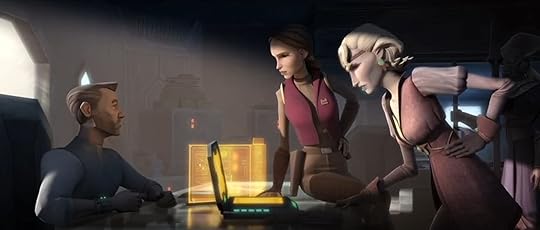
Eventually, their investigations reveal that Prime Minister Almec is leading the black market in a misguided attempt to help Mandalore’s citizens. He is removed from power and arrested.
S3E12: “Nightsisters” | S3E13: “Monster” | S3E14: “Witches of the Mist”
This arc of three episodes doesn’t relate directly to Mandalore, but it’s an important primer for events that happen later.
In “Nightsisters,” Count Dooku is ordered by Darth Sidious to dispose of his apprentice Asajj Ventress. Rudderless, Asajj returns home to Dathomir to reunite with her tribe of witches known as the Nightsisters.
Does Dathomir sound familiar? It may because it’s the home planet of another famous Sith: Darth Maul. Not only are Asajj and Maul from the same species, but the Nightsisters had a hand in apprenticing Maul to Darth Sidious way back before Episode I: The Phantom Menace.
Asajj and the head of her tribe, Mother Talzin, hatch a plot to get revenge on Count Dooku. They will provide the count with a new apprentice, but one that they will secretly control.
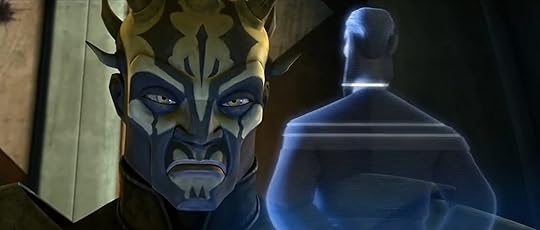
Dooku accepts the offer and is introduced to the fantastically named Savage Opress, who comes from the same family unit as Darth Maul. Whether through Nightsister magic or natural talent, Opress is a quick study in the ways of the Force. He’s also fond of the same kind of double-sided lightsabers favored by his kin, Darth Maul.
Unfortunately, Asajj tips her hand a bit too early, and both Dooku and Opress become aware of her plan. Realizing that he has been used, Opress flees after turning on both his creator and his master.
S4E14: “A Friend in Need”
(Note: The character Lux Bonteri features heavily in this episode but not in any other Mandalore arc, so I didn’t include the other episodes pertaining to him in this primer. For the purposes of this guide, you’ll learn most of what you need to know about Lux in this episode.)
This is a rare one-off episode that also has to do with Mandalore. During peace talks between the Republic and the Separatists hosted by Duchess Satine, the conference is interrupted by Lux Bonteri , who is promptly arrested. Fearing for his safety, Ahsoka goes to check on him only to be caught up in Lux’s plot to get revenge on Count Dooku for the death of Lux’s mother.
Lux has come to realize that neither the Republic nor the Separatists can give him what he wants, so he has found a third option: the remaining members of Death Watch, hiding now on the snowy planet of Carlac.
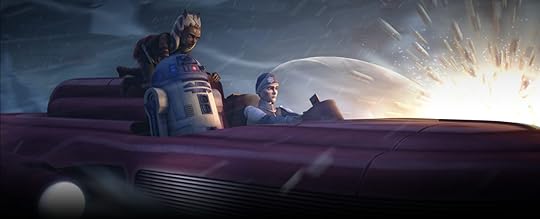
You see, Death Watch also wants revenge on Dooku after the failed coup against Duchess Satine. It would seem that their objectives align. The only problem is that Pre Vizsla is interested in his own ends — and will do anything to achieve them.
This episode is particularly important because it introduces the Death Watch character Bo-Katan and features the first meeting between her and Ahsoka.
S4E19: “Massacre” | S4E20: “Bounty” | S4E21: “Brothers” | S4E22: “Revenge”
This is another arc of episodes that doesn’t directly relate to Mandalore but is important for events that happen later.
Directionless again after her failed plot against Dooku, Asajj returns to the Nightsisters to become a full member of the tribe. The only problem is that Dooku is a tiny bit upset about the whole Savage Opress betrayal thing and orders the Nightsisters completely wiped out.
“Massacre” is a great battle episode that pits two forces of evil against each other. It even goes a bit further by making you sympathetic toward Asajj, who we’ve only seen so far as a villain.
With the Nightsisters tribe nearly destroyed, Asajj decides to try her hand at bounty hunting. In “Bounty” she takes up with a who’s who of famous Star Wars bounty hunters (including a young, armor-less Boba Fett) for an underground train job.
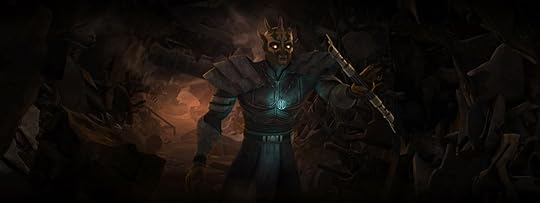
Meanwhile, Savage Opress has sought counsel from Mother Talzin on what to do next. She humbly suggests that Opress seek out his brother. What brother, you might ask? Oh you know, just the chopped-in-half Darth Maul who was assumed dead all these years.
Opress begins following Maul’s trail, which leads him to the junk planet Lotho Minor. Stories there abound about a creature living beneath the junk heaps and feeding on victims like some mechanical Shelob. As Opress comes to find out, these are more than just stories. Darth Maul is alive! Sustained by his rage and having constructed a spider body for himself, Maul has been living the life of an insane, muttering animal.
Opress captures Maul and returns to Mother Talzin, who restores Maul’s mind and legs with some sweet new prosthetics. Then the brothers lure Obi-Wan into a trap, where the Jedi is forced to team up with Asajj in order to survive. Ever want to see Kenobi use a red lightsaber? This is your chance.
S5E1: “Revival”
The season 5 premiere continues the arc that began at the end of season 4.
With Obi-Wan having slipped his grasp, Darth Maul begins his career as a criminal that will eventually culminate in him leading the Crimson Dawn syndicate.
But everyone has to start somewhere, and Maul decides that he’s going to co-opt some of Hondo Ohnaka’s pirates as a first step. Obi-Wan shows up to stop him, but Maul and Opress escape again.
This episode is important because it’s the beginning of Maul’s plan to form a powerful crime empire.
S5E14: “Eminence” | S5E15: “Shades of Reason” | S5E16: “The Lawless”
Out of fuel and drifting in space after their escape from Obi-Wan, Maul and Opress are rescued by none other than Death Watch. (See, I told you this was leading somewhere!) Building on his plan from the episode “Revival,” Maul proposes building a crime syndicate to help Pre Vizsla take over Mandalore once and for all. Pre Vizsla agrees.
Soon, Maul’s newly formed Shadow Collective is planning attacks on Mandalore, all so Death Watch can swoop in and “save” the planet from Maul’s violent invaders. Duchess Satine is deposed, and Pre Vizsla is primed to assume leadership of Mandalore.
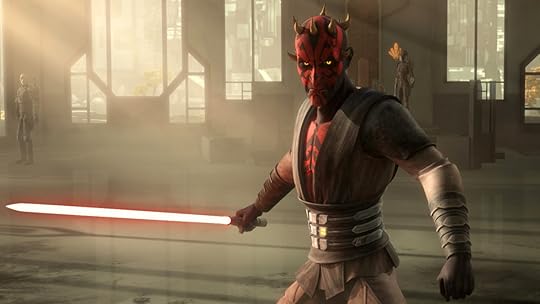
The only problem is that Pre Vizsla and Maul are working at cross purposes. These conflicting objectives collide when Maul challenges Pre Vizsla to single combat — and wins! Maul takes possession of the Darksaber. Bo-Katan leads a splinter group of Death Watch away from Mandalore after refusing to recognize Maul’s leadership. And Duchess Satine manages to get a distress call to Obi-Wan.
A new civil conflict breaks out on Mandalore. Those Death Watch loyal to Maul skirmish with the lawless warriors led by Bo-Katan. Prime Minister Almec, meanwhile, is freed from prison and restored to his post as a puppet leader under Maul.
Since Mandalore is still neutral, Obi-Wan must travel there alone to rescue Satine. He is also finally forced to confront the Sith lord he thought he killed years ago. Maul slays Satine, and Bo-Katan helps Obi-Wan escape. Bo-Katan reveals that she is Satine’s sister.
Maul is seemingly victorious, but his rule of Mandalore is short-lived. After sensing a disturbance in the Force, Darth Sidious arrives to capture his former apprentice. Sidious kills Savage Opress and overpowers Maul in single combat, taking Maul as his prisoner. More importantly, the Darksaber seems to disappear at the end of the duel. This is the last time that it will appear on-screen in Clone Wars.
S5E17: “Sabotage” | S5E18: “The Jedi Who Knew Too Much” | S5E19: “To Catch a Jedi” | S5E20: “The Wrong Jedi”
This arc of four episodes is purely optional, though you may want to watch it because there’s a lot of background information here for understanding the events that occur in season 7. There’s also an appearance by Asajj in her continued career as a bounty hunter.
That having been said, there’s nothing here related to Mandalore, and it may be enough for you to simply know that Ahsoka decided to leave the Jedi Order after being wrongly accused of murder and becoming disillusioned with the path of the Jedi.
S6E1: “The Unknown” | S6E2: “Conspiracy” | S6E3: “Fugitive” | S6E4: “Orders”
This arc of four episodes is even more optional than the previous four and is summarized succinctly near the end of season 7. However, if you want to learn about how some people began to suspect that the control chips implanted in all clones might have a sinister purpose related to Order 66, these are the episodes to watch.
Graphic Novel – Darth Maul: Son of Dathomir

This in-canon graphic novel is adapted from an unproduced arc from Clone Wars’ abbreviated sixth season.
A little bit of background: Clone Wars was cancelled after season 5, with only part of season 6 finished when the cancellation was announced. The completed 13 episodes went on to become “The Lost Missions,” which aired on Netflix.
At the same time, Lucasfilm released two print products from scripts that never went into production. The first was this graphic novel. The second was the book Dark Disciple.
While Son of Dathomir never aired on television, I would urge you to read it since it’s important to the Mandalore storyline. It also provides connective tissue between the events of “The Lawless” and Maul’s return in season 7.
After his defeat at the hands of Darth Sidious, Maul is brought to the planet Stygeon. Sidious, having realized the grave threat that Mother Talzin still poses, formulates a plan to destroy the head of the Nightsisters once and for all. For this, he will need help from both Count Dooku and General Grievous.
Maul isn’t imprisoned long before members of Death Watch come to his rescue. After fleeing from Stygeon, Maul reunites with the rest of his loyal Mandalorians on Zanbar. Prime Minister Almec returns the Darksaber to Maul, telling the former Sith that it was found in the courtyard after Maul’s duel with Sidious.
From there, a series of crosses and double-crosses take place as Maul seeks his revenge and Sidious seeks out Mother Talzin. And a few important reveals occur in the book’s fourth and final chapter.
First, we learn that “Mother” isn’t just Talzin’s title. She is actually Maul’s biological mother! Second, General Grievous succeeds in killing Talzin as she provides cover for Maul’s escape.
With his last tie to Dathomir cut, Maul retreats with the remaining members of Death Watch to cause more mischief elsewhere in the galaxy.
S7E5: “Gone With a Trace” | S7E6: “Deal No Deal” | S7E7: “Dangerous Debt” | S7E8: “Together Again”
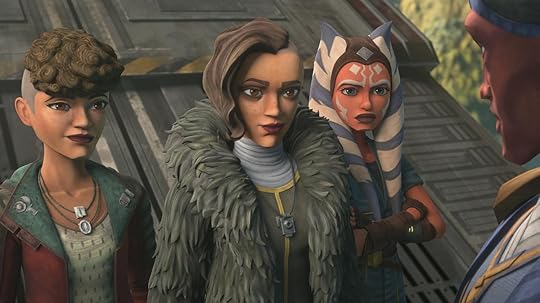
At first, this arc of episodes doesn’t seem to have much bearing on Mandalore. After leaving the Jedi Order, Ahsoka wanders aimlessly around Coruscant until her transport breaks down. Stranded on the edge of the undercity, she meets Trace Martez and her street-smart sister Rafa. Always on the hunt for credits, Rafa lines up a job transporting spice. Ahsoka reluctantly agrees to travel with the sisters.
Of course, the job goes sideways and the trio soon find themselves prisoners of the Pyke crime syndicate on Oba Diah. Escape attempts are made, deals are brokered, and it soon becomes clear that the Pykes aren’t the only ones keeping tabs on Ahsoka. You see, there’s also a trio of hooded figures in very familiar armor hanging around. Not only that, but the person overseeing the Pykes is Darth Maul, last seen after the death of Mother Talzin.
Ahsoka and the Martez sisters eventually break free and return to Coruscant. They haven’t even been home for five minutes when one of the hooded figures reveals themselves to be Bo-Katan. There’s trouble back on Mandalore, and the former Death Watch warrior wants Ahsoka’s help …
S7E9: “Old Friends Not Forgotten” | S7E10: “The Phantom Apprentice” | S7E11: “Shattered” | S7E12: “Victory and Death”
This arc is not only the last one dealing with Mandalore, but also the series finale. And it’s a good one. These four episodes, in my opinion, showed the potential of what Clone Wars could have been at its best. By abandoning the fortune cookie intro and taking a masterful risk with the score, these last episodes are some of the best in the whole series.
“Old Friends Not Forgotten” opens with Ahsoka and Bo-Katan reaching out to Obi-Wan for help. Though the Republic has been forbidden to interfere with Mandalore because of the planet’s neutrality, Ahsoka finally convinces Obi-Wan to send a detachment of clone troops to help apprehend Darth Maul, who has resurfaced on Mandalore. Before departing, Anakin gives back Ahsoka’s lightsabers from when she left the Jedi Order. This is the last time they will see each other.
Back on Mandalore, the hunt for Maul begins in earnest. As Maul’s faction of Death Watch battles Bo-Katan’s splinter group and the Republic forces, audiences finally get to see the so-called Siege of Mandalore.

What’s really masterful here is how these last episodes intertwine with the events of Revenge of the Sith, which is happening simultaneously. Ahsoka faces off against Maul in an epic duel that ends in Maul’s capture. They board a ship to deliver him to the Jedi Council.
Unfortunately, the command is given to initiate Order 66 before Maul can be returned to Coruscant. Ahsoka manages to disable Commander Rex’s control chip (this is where the info from season 6 comes into play), and the two escape after Maul causes considerable chaos on the ship. Ahsoka, Rex, and Maul go their various ways, setting up the roles they will play in Rebels and after.
Notably, Maul has possession of the Darksaber at the end of the Son of Dathomir graphic novel, but it does not appear in this arc of episodes.
---
I have to say that this project really improved my opinion of the Clone Wars animated series. Some of the episodes here are weaker than others, and the show overall is not as strong as Rebels in my mind, but I did enjoy watching many of these story arcs. And I feel like a lot of details from both Rebels and The Mandalorian make a lot more sense now.
So how did I do? Did I miss any? Let me know in the comments. Otherwise, happy watching, and may the Force be with you!
Published on May 23, 2020 10:42
•
Tags:
clone-wars, disney, disney-plus, star-wars, tv
January 29, 2019
Magic: The Gathering Comics Reread Project Table of Contents
TABLE OF CONTENTS
For ease of accessing all of the entries in The Great Magic: The Gathering Comics Reread project, links to every installment can be found in chronological order below.
Project Introduction: The Great Magic: The Gathering Comics Reread!
Elder Dragons
Dakkon Blackblade
Fallen Angel
Arabian Nights
Antiquities War
Urza-Mishra War
Fallen Empires
Ice Age
Shandalar
Serra Angel
The Legend of Jedit Ojanen
Homelands
The Shadow Mage
Nightmare
Wayfarer
Convocations — A Magic: The Gathering Gallery
Musings Magic Special
Project Capstone and Closeout: Interview with Jeff Gomez
For ease of accessing all of the entries in The Great Magic: The Gathering Comics Reread project, links to every installment can be found in chronological order below.
Project Introduction: The Great Magic: The Gathering Comics Reread!
Elder Dragons
Dakkon Blackblade
Fallen Angel
Arabian Nights
Antiquities War
Urza-Mishra War
Fallen Empires
Ice Age
Shandalar
Serra Angel
The Legend of Jedit Ojanen
Homelands
The Shadow Mage
Nightmare
Wayfarer
Convocations — A Magic: The Gathering Gallery
Musings Magic Special
Project Capstone and Closeout: Interview with Jeff Gomez
Published on January 29, 2019 10:30
•
Tags:
comic-books, comics, magic-the-gathering, mtg, wizards-of-the-coast, wotc
November 23, 2018
Rat Queens Collected Vol. 5 Explained
Midway through the summer of 2018, I discovered the comic series Rat Queens. The first collected volume had been on my to-read list for some time, so I finally decided to pull the trigger.
This elicited a reading and buying spree in which I quickly devoured all of the series that had been collected so far. I also learned about some of the behind-the-scenes drama that has dogged the series almost since its inception.
After an extended hiatus and soft reboot in March 2017, Rat Queens finally seemed to be on an even keel with a steady creative team of writer / co-creator Kurtis Wiebe and artist Owen Gieni. The only problem was that the story didn't quite line up with the events of Collected Volume 3 and individual issue #16, which is not part of any collection (more on this in a moment).
Then comes Rat Queens Collected Volume 5: The Colossal Magic Nothing.
Whoo boy, this one's a doozy. Through magic, alternate realities, and time travel, this volume tries to explain the series hiatus and the seemingly unresolved story lines that were left as cliffhangers before the reboot.
The first time I read it, the story made no sense. But when I went back and reread it again almost immediately, it began to come together.
I personally couldn't find anyone who had comprehensively explained the events of Rat Queens from the end of Collected Volume 3 onward, so this is my attempt to do so.
Note #1: Obviously, there are SPOILERS AHEAD. Proceed at your own risk.
Note #2: When talking about "collected volumes," I'm referring to the paperback collections. The chapters that make up the collected volumes are numbered the same as the individual issues from which they are reprinted.
Unfortunately, the individual issues of Rat Queens are also divided into two "volumes," indicated by individual issue #1 through #16 and individual issue #1 following the 2017 reboot onward. If I'm talking about an individual issue, I will try to refer to it as either the chapter from the collected volume in which it appears (ex. Collected Volume 3, Chapter 12) or the series volume and issue (ex. Series Volume 1, Issue #12) or both (ex. Collected Volume 3, Chapter 12 / Series Volume 1, Issue #12).
RAT QUEENS COLLECTED VOLUME 5 EXPLAINED
(Once again, spoilers ahead)
The initial Rat Queens story takes place over the first 15 issues which are assembled in Collected Volumes 1 through 3.
At the end of Collected Vol. 3, Chapter 15, Hannah has been placed in a void prison outside of time and space by the council at Mage U. Meanwhile, Betty, Violet, and Dee have boarded a ship to continue their adventures without Hannah.
This story continues in Series Volume 1, Issue #16. This issue does not appear in any collected volume. This is because Wiebe and artist Tess Fowler had a major professional clash, and the two would not consent to work together to continue the story arc started in Series Volume 1, Issue #16. Rat Queens went on hiatus and launched Series Volume 2, Issue #1 (Collected Volume 4, Chapter 1) as a soft reboot.
Except Series Volume 2 isn't a reboot at all.
In Series Volume 1, Issue #16, Betty, Violet, and Dee return to Palisade to find that the entire town has been replaced with doppelgangers. Violet kills impostor Orc Dave and the issue ends.
This narrative doesn't continue until Collected Volume 5, Chapter 9 (Series Volume 2, Issue #9). Here's what happens:
* Dee has a flashback to her youth and a romance with a young man named Adua.
* Dee recalls how she met Violet and the rest of the Rat Queens.
* Dee revisits the events at Mage U, where they let Hannah storm off and eventually become imprisoned.
* There is then a brief synopsis of Series Volume 1, Issue #16. Betty, Violet, and Dee return to Palisade to find that the entire town has been replaced with doppelgangers. Violet kills impostor Orc Dave.
* At some point in the future (we know because Dee's hair style and Violet's beard are different), Dee decides she needs to return home to take up the religious mantle she's been running from.
* Time passes. At this point, it has been 20 years since Hannah's imprisonment. Dee, now the religious leader of her people, begins a romance with Adua again. While in bed, Dee receives a message from one of Violet's daughters.
* Dee travels to a reunion with her remaining friends. Betty and Violet are both married with children.
* Violet tells Dee of a corruption in part of her kingdom. The three Queens decide to investigate.
* At a ruined tower, Dee, Violet, and Betty discover the source of the corruption. It's Hannah, who made a pact with her demon, killed him, and has been amassing power for two decades. A battle ensues. Hannah wins and vows to continue her campaign of terror.
* Dee vows that they can still save Hannah. She returns home and communes with the god N'Rygoth, who is kept slumbering by the sacrifices of Dee's people. In the time before N'Rygoth slept, his violent energies threatened not only the world, but the universe (or multiverse).
* Dee asks N'Rygoth to awaken, to "Hear me, and unravel time. Let me control the flow of reality." N'Rygoth awakens (probably a bad thing) and does as Dee asks.
* Dee travels back in time to the events in Collected Vol. 3, Chapter 15, where Hannah is about to storm off. Instead of letting her leave, they vow to help and support her while also tempering her worst impulses.
--
At this point, the timeline in the comic splits in two. Timeline A covers the events up to Collected Vol. 3, Chapter 15; Series Volume 1, Issue #16; and Collected Volume 5, Chapter 9. Hannah ends up in prison.
Timeline B1 begins when the Rat Queens refuse to let Hannah storm off at Mage U. They find a diplomatic solution to the "uprising" started by Hannah's father, Gerard. Hannah DOES NOT end up in prison. Gerard survives and travels back to Palisade with the Queens. Then begins the events in Collected Volume 4, Chapter 1.
EXCEPT ... there's still a version of imprisoned Hannah floating around, presumably because she was placed in a void prison outside of time and space. We don't know if this is the version of Hannah from Timeline A, manifesting in Timeline B, or a second version of imprisoned Hannah. The fact is that the imprisoned Hannah from Timeline A looks markedly different than the imprisoned Hannah that manifests in Timeline B. Their stories, however, are the same: imprisonment, demon pact, demon killed for his power, revenge.
Timeline B1 continues in Collected Volume 5, Chapters 6-8 and 10. The imprisoned Hannah in Timeline B is altering space-time to remove people from reality, notably the Queens and a few townspeople like the barkeeper's daughter. This creates subsets of Timeline B:
* Timeline B2: Madeline, the barkeep's daughter, does not exist. The barkeep is a bitter old man. There is a rival bar called The Brood in town.
* Timeline B3: Violet (and her brother Barrie) don't exist. Braga never joins the Rat Queens. Hannah is imprisoned at Vaale for destroying half of Palisade.
* Timeline B4: We don't know much about this timeline except that Dee realizes she split reality. Dee is erased from existence. Betty discovers that the imprisoned Hannah manifesting in Timeline B is behind everything.
* Timeline B1a: The same as timeline B1. No one has been erased, BUT Betty has the knowledge that the timelines have split and that there's a rogue Hannah moving through time and space.
--
Whew!
Since I haven't read beyond Collected Volume 5, Chapter 10 (Series Volume 2, Issue #10), I don't know what happens after that. But that's how I interpret it al.
As I mention in my review, I don't know if this was brilliant storytelling or pure insanity, but Wiebe does leave a lot of fun breadcrumbs for readers who decide to undertake subsequent rereads.
Did I miss anything? Let me know if the comments!
This elicited a reading and buying spree in which I quickly devoured all of the series that had been collected so far. I also learned about some of the behind-the-scenes drama that has dogged the series almost since its inception.
After an extended hiatus and soft reboot in March 2017, Rat Queens finally seemed to be on an even keel with a steady creative team of writer / co-creator Kurtis Wiebe and artist Owen Gieni. The only problem was that the story didn't quite line up with the events of Collected Volume 3 and individual issue #16, which is not part of any collection (more on this in a moment).
Then comes Rat Queens Collected Volume 5: The Colossal Magic Nothing.
Whoo boy, this one's a doozy. Through magic, alternate realities, and time travel, this volume tries to explain the series hiatus and the seemingly unresolved story lines that were left as cliffhangers before the reboot.
The first time I read it, the story made no sense. But when I went back and reread it again almost immediately, it began to come together.
I personally couldn't find anyone who had comprehensively explained the events of Rat Queens from the end of Collected Volume 3 onward, so this is my attempt to do so.
Note #1: Obviously, there are SPOILERS AHEAD. Proceed at your own risk.
Note #2: When talking about "collected volumes," I'm referring to the paperback collections. The chapters that make up the collected volumes are numbered the same as the individual issues from which they are reprinted.
Unfortunately, the individual issues of Rat Queens are also divided into two "volumes," indicated by individual issue #1 through #16 and individual issue #1 following the 2017 reboot onward. If I'm talking about an individual issue, I will try to refer to it as either the chapter from the collected volume in which it appears (ex. Collected Volume 3, Chapter 12) or the series volume and issue (ex. Series Volume 1, Issue #12) or both (ex. Collected Volume 3, Chapter 12 / Series Volume 1, Issue #12).
RAT QUEENS COLLECTED VOLUME 5 EXPLAINED
(Once again, spoilers ahead)
The initial Rat Queens story takes place over the first 15 issues which are assembled in Collected Volumes 1 through 3.
At the end of Collected Vol. 3, Chapter 15, Hannah has been placed in a void prison outside of time and space by the council at Mage U. Meanwhile, Betty, Violet, and Dee have boarded a ship to continue their adventures without Hannah.
This story continues in Series Volume 1, Issue #16. This issue does not appear in any collected volume. This is because Wiebe and artist Tess Fowler had a major professional clash, and the two would not consent to work together to continue the story arc started in Series Volume 1, Issue #16. Rat Queens went on hiatus and launched Series Volume 2, Issue #1 (Collected Volume 4, Chapter 1) as a soft reboot.
Except Series Volume 2 isn't a reboot at all.
In Series Volume 1, Issue #16, Betty, Violet, and Dee return to Palisade to find that the entire town has been replaced with doppelgangers. Violet kills impostor Orc Dave and the issue ends.
This narrative doesn't continue until Collected Volume 5, Chapter 9 (Series Volume 2, Issue #9). Here's what happens:
* Dee has a flashback to her youth and a romance with a young man named Adua.
* Dee recalls how she met Violet and the rest of the Rat Queens.
* Dee revisits the events at Mage U, where they let Hannah storm off and eventually become imprisoned.
* There is then a brief synopsis of Series Volume 1, Issue #16. Betty, Violet, and Dee return to Palisade to find that the entire town has been replaced with doppelgangers. Violet kills impostor Orc Dave.
* At some point in the future (we know because Dee's hair style and Violet's beard are different), Dee decides she needs to return home to take up the religious mantle she's been running from.
* Time passes. At this point, it has been 20 years since Hannah's imprisonment. Dee, now the religious leader of her people, begins a romance with Adua again. While in bed, Dee receives a message from one of Violet's daughters.
* Dee travels to a reunion with her remaining friends. Betty and Violet are both married with children.
* Violet tells Dee of a corruption in part of her kingdom. The three Queens decide to investigate.
* At a ruined tower, Dee, Violet, and Betty discover the source of the corruption. It's Hannah, who made a pact with her demon, killed him, and has been amassing power for two decades. A battle ensues. Hannah wins and vows to continue her campaign of terror.
* Dee vows that they can still save Hannah. She returns home and communes with the god N'Rygoth, who is kept slumbering by the sacrifices of Dee's people. In the time before N'Rygoth slept, his violent energies threatened not only the world, but the universe (or multiverse).
* Dee asks N'Rygoth to awaken, to "Hear me, and unravel time. Let me control the flow of reality." N'Rygoth awakens (probably a bad thing) and does as Dee asks.
* Dee travels back in time to the events in Collected Vol. 3, Chapter 15, where Hannah is about to storm off. Instead of letting her leave, they vow to help and support her while also tempering her worst impulses.
--
At this point, the timeline in the comic splits in two. Timeline A covers the events up to Collected Vol. 3, Chapter 15; Series Volume 1, Issue #16; and Collected Volume 5, Chapter 9. Hannah ends up in prison.
Timeline B1 begins when the Rat Queens refuse to let Hannah storm off at Mage U. They find a diplomatic solution to the "uprising" started by Hannah's father, Gerard. Hannah DOES NOT end up in prison. Gerard survives and travels back to Palisade with the Queens. Then begins the events in Collected Volume 4, Chapter 1.
EXCEPT ... there's still a version of imprisoned Hannah floating around, presumably because she was placed in a void prison outside of time and space. We don't know if this is the version of Hannah from Timeline A, manifesting in Timeline B, or a second version of imprisoned Hannah. The fact is that the imprisoned Hannah from Timeline A looks markedly different than the imprisoned Hannah that manifests in Timeline B. Their stories, however, are the same: imprisonment, demon pact, demon killed for his power, revenge.
Timeline B1 continues in Collected Volume 5, Chapters 6-8 and 10. The imprisoned Hannah in Timeline B is altering space-time to remove people from reality, notably the Queens and a few townspeople like the barkeeper's daughter. This creates subsets of Timeline B:
* Timeline B2: Madeline, the barkeep's daughter, does not exist. The barkeep is a bitter old man. There is a rival bar called The Brood in town.
* Timeline B3: Violet (and her brother Barrie) don't exist. Braga never joins the Rat Queens. Hannah is imprisoned at Vaale for destroying half of Palisade.
* Timeline B4: We don't know much about this timeline except that Dee realizes she split reality. Dee is erased from existence. Betty discovers that the imprisoned Hannah manifesting in Timeline B is behind everything.
* Timeline B1a: The same as timeline B1. No one has been erased, BUT Betty has the knowledge that the timelines have split and that there's a rogue Hannah moving through time and space.
--
Whew!
Since I haven't read beyond Collected Volume 5, Chapter 10 (Series Volume 2, Issue #10), I don't know what happens after that. But that's how I interpret it al.
As I mention in my review, I don't know if this was brilliant storytelling or pure insanity, but Wiebe does leave a lot of fun breadcrumbs for readers who decide to undertake subsequent rereads.
Did I miss anything? Let me know if the comments!
Published on November 23, 2018 17:12
•
Tags:
comic-books, comics, multiverse, rat-queens, time-travel
August 12, 2018
MTG Comics Reread: Jeff Gomez Interview
As a capstone to the MTG Comics Reread Project, I had the great pleasure of interviewing Jeff Gomez. Corresponding with Jeff first on Twitter and then via email was a great delight. Getting to pick his brain about the Armada MTG comics was something my younger self could have never imagined when I was buying these comics with my mom all those years ago.
If you’ve been reading these entries as frequently as I’ve been writing them, you know that Jeff was the guiding editorial force behind the Armada MTG comics. An avid gamer, Jeff started his career in gaming journalism at Gateways magazine before moving to Valiant Comics in 1992.
After leaving the comics and video game industry in the late-1990s, Jeff co-founded Starlight Runner Entertainment in 2000 with Mark Pensavalle and Chrysoula Artemis. As CEO, Jeff has helped steer transmedia strategies for Fortune 500 companies like Disney and Sony, and entertainment franchises like Pirates of the Caribbean, Halo, Avatar, and Spider-Man.
In addition to his duties at Starlight Runner, Jeff actively teaches and writes about media and storytelling topics. We conducted this interview via email.
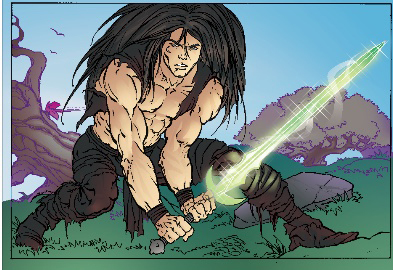
(Jared Carthalion as drawn by Rags Morales for the Battlemage video game. Image courtesy of Jeff Gomez.)
Pat Scalisi: For those who aren’t familiar with the story, can you briefly explain how you got involved in helping create the first-ever Magic: The Gathering comics for Armada in the mid-1990s?
Jeff Gomez: While working at Valiant Comics in the early 1990s, I learned that the video game company Acclaim Entertainment (makers of the Mortal Kombat series) intended to buy Valiant in the hopes of adapting [Valiant’s] superheroes into games. Because of my background in tabletop adventure games and my understanding of video game technology, I volunteered to help select and develop the games from the Valiant side. My pick for the first big Nintendo 64 game was Turok, Dinosaur Hunter, and I submitted a concept document that led to my being a producer on the game. It was a huge success.
Valiant asked me what else outside of their superhero line would make a good comic book and video game combo, and I recommended a trading card game being made by some friends of mine from my days as a tabletop game writer. The game was called Magic: The Gathering, and I knew it was going to be a hit because my schoolteacher friends were already annoyed with kids playing with the cards in class! My bosses at Valiant told me to see what it would take to pick up the game as a license for comics and videogames. They gave me a $300 budget to create a presentation and a roundtrip ticket to Renton, Wash., to visit Wizards of the Coast (WotC).

(The offices of Wizards of the Coast in Renton, Wash. Photo courtesy of Wizards of the Coast.)
In the interim, I checked out what WotC was doing licensing-wise and learned that they had already cut a deal with HarperCollins to publish novels based on the fantasy world alluded to in the cards. One of my best friends, Mark Pensavalle, worked for the publisher, and I got him to sneak me the galley of the first Magic: The Gathering novel, Arena. Reading it, I realized that there was huge potential in building a fantasy world based on the cards, but that these books were not really dealing with the coolest aspects of it, like Planeswalkers and major magic duels. That would be the stuff of comic books and video games!
When I got to WotC, I learned that there was fierce competition for the Magic license from all the comic book companies, including Marvel and DC. I guess what made us stand out was that we also wanted the game license and that I had a lot of experience helping to build expansive fantasy worlds. I also loved the game and had a strong desire to help establish an epic narrative that tied a lot of disparate concepts and wildly different game decks together into a single continuity. How could they resist?
Once they said yes, Valiant turned to me to figure out how to pull all of this off. Finding a writer to create the comics and games so quickly was nearly impossible, so I volunteered to write the comics and games myself, and somehow the powers that be agreed.
They gave me less than a month to have the first script in production as a comic, so I took a shortcut. I went to one of my original Dungeons & Dragons campaign settings, The Land of Corondor, and plopped it down in the middle of Dominaria. That way I could wreck the place and have some creative freedom without messing with the rest of the Magic multiverse too badly.
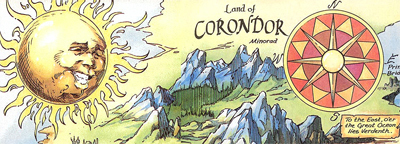
(Detail of the map of Corondor from Shadow Mage issue 4.)
But soon WotC was giving me the freedom to do some amazing things, like tell the origin story of Dakkon Blackblade and set it on Corondor. They also let me tell stories set elsewhere on Dominaria during the Ice Age era, allowing me to tie my various comic book series together in the form of a grand epic that took place over the course of many centuries. Before long, my team and I were creating canon for the Magic universe, a lot of which persists to this day.
Pat: That’s right! Fast forward nearly 25 years. Wizards of the Coast releases the 2018 Dominaria set, and part of the inciting incident for the plot is drawn directly from the Dakkon Blackblade comic! Could you have imagined that plot threads from the comics would still be impacting Magic’s story more than two decades later?
Jeff: For a while I was melancholy about the notion that my work on Magic: The Gathering would not be remembered. A few of the stories had been retconned out of existence when the franchise took a different creative direction in the late 1990s. But I’ve also been around long enough to see that everything old becomes new again, and that we sometimes look back at things that were meaningful when we were young and want to revisit them. To see this happen with the hard work I did over 20 years ago is simply amazing.
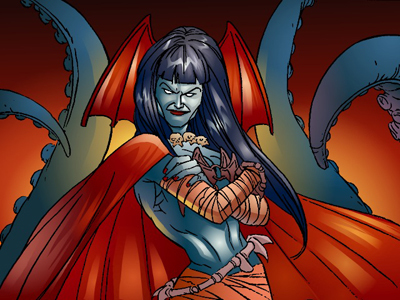

(Top: Geyadrone Dihada, the Planeswalker who manipulated Dakkon into crafting the fearsome Blackblade. Bottom: The Blackblade Reforged from the 2018 Dominaria expansion set. Bottom art by Chris Rahn.)
I love that the Dakkon Blackblade story (which was also the origin story for the whole Carthalion family saga that tied together the comics and video games) is intrinsic to the new Dominaria set. But you know what I love even more? The fact that people like you and Multiverse in Review are revisiting the old work in such a fun, detailed, and passionate way.
Pat: I’m glad you mentioned Multiverse in Review, because that ties into my next question. One of the biggest frustrations for fans to this day is that the comic line came to an abrupt end before the Planeswalker War story could be told in full. Berend at Multiverse in Review did a great job uncovering what might have been. Do you think we’ll ever get an official conclusion to the storyline?
Jeff: Would I like to finish that storyline? Hell, yeah! Running just short of Planeswalker War before cancellation was one of the most crushing disappointments of my career. What’s funny is that the Magic comics were cancelled because they were only selling 40,000 to 60,000 copies a piece. Those would be very respectable numbers for any comic only a year or so later. Heck, they’d be great numbers today!

(The cover to what would have been Planeswalker War issue 1. Art by Rags Morales.)
Planeswalker War could well be rewritten to fit within the parameters of the WotC chronology retcon. We haven’t seen much of Corondor in the lore since, and not all that much has been acknowledged about what happened there in the new Dominaria narratives. So it could well be possible, and I might humbly add, it could be pretty satisfying for all fans. There haven’t been many events in the narrative that have been so colossal in scope.
Pat: Turning to the creative side, some of the folks you worked with — like Val Mayerik and Bill Sienkiewicz — were and continue to be huge names in the fantasy and sci-fi fields. Others were just starting out and went on to have significant careers in comics, advertising, and entertainment. What was it like to work with this unique and talented pool of creators?
Jeff: I had only been a comic book editor for a year or so before Magic came along. Before that I was a collector and enthusiast like any other fan. So the prospect of working with this incredible talent, guys whose work I was staring at in issues of New Mutants or Master of Kung Fu — it was mind-blowing.
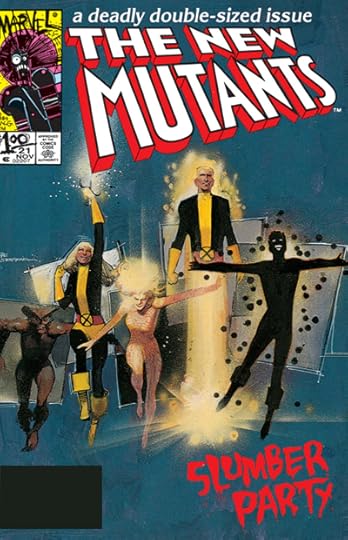
(Bill Sienkiewicz’s cover for New Mutants issue 21 during his iconic run on the title.)
When Alex Maleev first came to the office, he showed up at my cubicle because I was one of the only editors who would look at a portfolio from right off the street. I was a bit busy, but he told me, “If you don’t look at my portfolio, I will throw myself out the window.” I looked and gave him Magic: The Gathering’s Fallen Empires almost immediately.
Alex is one of my greatest discoveries. Doug Tropea-Wheatley is another. He did Elder Dragons for me, and I still have his pencil of the two-page Palladia Mors splash hanging in my living room. Charles Vess, Mike Kaluta, Greg Hildebrandt — these were some of the greatest fantasy illustrators of all time. I was in heaven!
Pat: What’s your favorite memory or memories from working on the Magic comic line?
Jeff: The time I spent at WotC feels like a dream. The place was located near these amazing forests. Mount Rainier hovered in the distance like Valhalla and Olympus. Hundreds of cubicles jammed with dragons, movie posters, and fantasy collectibles. Lights dim, sound hushed. Dead Can Dance playing somewhere in the background. And I was there to help figure out how the system of magic worked in the Dominia multiverse. I was there to get permission to put Corondor and the Magic chronology on something new called a “web page.” I was there to help create a brand new fantasy canon that would last for years and years.
The only thing that could remotely rival those days was when I saw my name on the cover of Magic: The Gathering’s The Shadow Mage. There’s Jared Carthalion, with a scar on his face just like mine, a freaky kid whose strongest power was not his innate Planeswalker magic, but his ability to unite other freaky people.

(The Diamond Distribution catalog declares Shadow Mage issue 1 its “Gem of the Month.” “This was one of the most exciting moments of my life!” says Jeff.)
Pat: I know you’re busy with all you do for Starlight Runner Entertainment, so I wanted to thank you for taking the time to chat. So many Magic fans continue to enjoy and read these comics. Many are rediscovering them because of the recent expansions. Is there anything you’d like to say to those fans today?
Jeff: Since Magic, I’ve gotten to work on so many amazing story worlds: Avatar, Pirates of the Caribbean, Halo, Men in Black, Tron, Teenage Mutant Ninja Turtles. But Magic fans have always been special because they seem to understand the nature of my contributions and have appreciated the details and levels of complexity in the work. I think that’s wonderful and so, there’s a special place in my heart for those fans.
Some of them tell me that they wish they could be doing what I do for a living but that it seems impossible. I want to tell you all that it’s not. In fact, nowadays it’s more possible to get involved in entertainment and create great games and story worlds than ever before. The entertainment machine is massive. Companies need new, original content from a diversity of perspectives. So, when I get asked how I managed to do these things, I tell people that it’s pretty simple: I walked up to the things I loved and asked, “How does this work?”

(One of Starlight Runner Entertainment’s case studies.)
After studying how it works and then moving into situations where the work is getting done, I was able to step forward and say, “Yeah, I know how this works.” The money comes when you know how it works so well that you can imitate it and innovate it. You’re making it work.
I studied fantasy roleplaying games because I wondered how they worked. I saw that they were built on systems of rules, that there was a balance to them, numbers before imagination is added. That was what made me able to talk with deep understanding to Richard Garfield, who built Magic on top of algebraic equations. To understand the math is what made Skaff Elias at WotC, and to a certain extent myself, able to help devise the magic system on top of the math.
Card games, films, television, apps, theme park rides — “How does this work?”
When I know how they work (not guessing, knowing), then I can speak to the people involved and not embarrass myself. And they appreciate that I know their language, which they thought was a secret language. So, I get to be part of the club. I get to contribute my ideas. The job is mine to screw up.
It gives me great joy to know that there are fans who still appreciate my work after many years. But it would give me even more satisfaction to know that those fans are living joyous and fulfilling lives. That somehow these fantasies have helped to guide us all toward a better reality.
And feel free to jump on my social media! Twitter: @Jeff_Gomez and Facebook: Starlight Runner Entertainment.

If you’ve been reading these entries as frequently as I’ve been writing them, you know that Jeff was the guiding editorial force behind the Armada MTG comics. An avid gamer, Jeff started his career in gaming journalism at Gateways magazine before moving to Valiant Comics in 1992.
After leaving the comics and video game industry in the late-1990s, Jeff co-founded Starlight Runner Entertainment in 2000 with Mark Pensavalle and Chrysoula Artemis. As CEO, Jeff has helped steer transmedia strategies for Fortune 500 companies like Disney and Sony, and entertainment franchises like Pirates of the Caribbean, Halo, Avatar, and Spider-Man.
In addition to his duties at Starlight Runner, Jeff actively teaches and writes about media and storytelling topics. We conducted this interview via email.

(Jared Carthalion as drawn by Rags Morales for the Battlemage video game. Image courtesy of Jeff Gomez.)
Pat Scalisi: For those who aren’t familiar with the story, can you briefly explain how you got involved in helping create the first-ever Magic: The Gathering comics for Armada in the mid-1990s?
Jeff Gomez: While working at Valiant Comics in the early 1990s, I learned that the video game company Acclaim Entertainment (makers of the Mortal Kombat series) intended to buy Valiant in the hopes of adapting [Valiant’s] superheroes into games. Because of my background in tabletop adventure games and my understanding of video game technology, I volunteered to help select and develop the games from the Valiant side. My pick for the first big Nintendo 64 game was Turok, Dinosaur Hunter, and I submitted a concept document that led to my being a producer on the game. It was a huge success.
Valiant asked me what else outside of their superhero line would make a good comic book and video game combo, and I recommended a trading card game being made by some friends of mine from my days as a tabletop game writer. The game was called Magic: The Gathering, and I knew it was going to be a hit because my schoolteacher friends were already annoyed with kids playing with the cards in class! My bosses at Valiant told me to see what it would take to pick up the game as a license for comics and videogames. They gave me a $300 budget to create a presentation and a roundtrip ticket to Renton, Wash., to visit Wizards of the Coast (WotC).

(The offices of Wizards of the Coast in Renton, Wash. Photo courtesy of Wizards of the Coast.)
In the interim, I checked out what WotC was doing licensing-wise and learned that they had already cut a deal with HarperCollins to publish novels based on the fantasy world alluded to in the cards. One of my best friends, Mark Pensavalle, worked for the publisher, and I got him to sneak me the galley of the first Magic: The Gathering novel, Arena. Reading it, I realized that there was huge potential in building a fantasy world based on the cards, but that these books were not really dealing with the coolest aspects of it, like Planeswalkers and major magic duels. That would be the stuff of comic books and video games!
When I got to WotC, I learned that there was fierce competition for the Magic license from all the comic book companies, including Marvel and DC. I guess what made us stand out was that we also wanted the game license and that I had a lot of experience helping to build expansive fantasy worlds. I also loved the game and had a strong desire to help establish an epic narrative that tied a lot of disparate concepts and wildly different game decks together into a single continuity. How could they resist?
Once they said yes, Valiant turned to me to figure out how to pull all of this off. Finding a writer to create the comics and games so quickly was nearly impossible, so I volunteered to write the comics and games myself, and somehow the powers that be agreed.
They gave me less than a month to have the first script in production as a comic, so I took a shortcut. I went to one of my original Dungeons & Dragons campaign settings, The Land of Corondor, and plopped it down in the middle of Dominaria. That way I could wreck the place and have some creative freedom without messing with the rest of the Magic multiverse too badly.

(Detail of the map of Corondor from Shadow Mage issue 4.)
But soon WotC was giving me the freedom to do some amazing things, like tell the origin story of Dakkon Blackblade and set it on Corondor. They also let me tell stories set elsewhere on Dominaria during the Ice Age era, allowing me to tie my various comic book series together in the form of a grand epic that took place over the course of many centuries. Before long, my team and I were creating canon for the Magic universe, a lot of which persists to this day.
Pat: That’s right! Fast forward nearly 25 years. Wizards of the Coast releases the 2018 Dominaria set, and part of the inciting incident for the plot is drawn directly from the Dakkon Blackblade comic! Could you have imagined that plot threads from the comics would still be impacting Magic’s story more than two decades later?
Jeff: For a while I was melancholy about the notion that my work on Magic: The Gathering would not be remembered. A few of the stories had been retconned out of existence when the franchise took a different creative direction in the late 1990s. But I’ve also been around long enough to see that everything old becomes new again, and that we sometimes look back at things that were meaningful when we were young and want to revisit them. To see this happen with the hard work I did over 20 years ago is simply amazing.


(Top: Geyadrone Dihada, the Planeswalker who manipulated Dakkon into crafting the fearsome Blackblade. Bottom: The Blackblade Reforged from the 2018 Dominaria expansion set. Bottom art by Chris Rahn.)
I love that the Dakkon Blackblade story (which was also the origin story for the whole Carthalion family saga that tied together the comics and video games) is intrinsic to the new Dominaria set. But you know what I love even more? The fact that people like you and Multiverse in Review are revisiting the old work in such a fun, detailed, and passionate way.
Pat: I’m glad you mentioned Multiverse in Review, because that ties into my next question. One of the biggest frustrations for fans to this day is that the comic line came to an abrupt end before the Planeswalker War story could be told in full. Berend at Multiverse in Review did a great job uncovering what might have been. Do you think we’ll ever get an official conclusion to the storyline?
Jeff: Would I like to finish that storyline? Hell, yeah! Running just short of Planeswalker War before cancellation was one of the most crushing disappointments of my career. What’s funny is that the Magic comics were cancelled because they were only selling 40,000 to 60,000 copies a piece. Those would be very respectable numbers for any comic only a year or so later. Heck, they’d be great numbers today!

(The cover to what would have been Planeswalker War issue 1. Art by Rags Morales.)
Planeswalker War could well be rewritten to fit within the parameters of the WotC chronology retcon. We haven’t seen much of Corondor in the lore since, and not all that much has been acknowledged about what happened there in the new Dominaria narratives. So it could well be possible, and I might humbly add, it could be pretty satisfying for all fans. There haven’t been many events in the narrative that have been so colossal in scope.
Pat: Turning to the creative side, some of the folks you worked with — like Val Mayerik and Bill Sienkiewicz — were and continue to be huge names in the fantasy and sci-fi fields. Others were just starting out and went on to have significant careers in comics, advertising, and entertainment. What was it like to work with this unique and talented pool of creators?
Jeff: I had only been a comic book editor for a year or so before Magic came along. Before that I was a collector and enthusiast like any other fan. So the prospect of working with this incredible talent, guys whose work I was staring at in issues of New Mutants or Master of Kung Fu — it was mind-blowing.

(Bill Sienkiewicz’s cover for New Mutants issue 21 during his iconic run on the title.)
When Alex Maleev first came to the office, he showed up at my cubicle because I was one of the only editors who would look at a portfolio from right off the street. I was a bit busy, but he told me, “If you don’t look at my portfolio, I will throw myself out the window.” I looked and gave him Magic: The Gathering’s Fallen Empires almost immediately.
Alex is one of my greatest discoveries. Doug Tropea-Wheatley is another. He did Elder Dragons for me, and I still have his pencil of the two-page Palladia Mors splash hanging in my living room. Charles Vess, Mike Kaluta, Greg Hildebrandt — these were some of the greatest fantasy illustrators of all time. I was in heaven!
Pat: What’s your favorite memory or memories from working on the Magic comic line?
Jeff: The time I spent at WotC feels like a dream. The place was located near these amazing forests. Mount Rainier hovered in the distance like Valhalla and Olympus. Hundreds of cubicles jammed with dragons, movie posters, and fantasy collectibles. Lights dim, sound hushed. Dead Can Dance playing somewhere in the background. And I was there to help figure out how the system of magic worked in the Dominia multiverse. I was there to get permission to put Corondor and the Magic chronology on something new called a “web page.” I was there to help create a brand new fantasy canon that would last for years and years.
The only thing that could remotely rival those days was when I saw my name on the cover of Magic: The Gathering’s The Shadow Mage. There’s Jared Carthalion, with a scar on his face just like mine, a freaky kid whose strongest power was not his innate Planeswalker magic, but his ability to unite other freaky people.

(The Diamond Distribution catalog declares Shadow Mage issue 1 its “Gem of the Month.” “This was one of the most exciting moments of my life!” says Jeff.)
Pat: I know you’re busy with all you do for Starlight Runner Entertainment, so I wanted to thank you for taking the time to chat. So many Magic fans continue to enjoy and read these comics. Many are rediscovering them because of the recent expansions. Is there anything you’d like to say to those fans today?
Jeff: Since Magic, I’ve gotten to work on so many amazing story worlds: Avatar, Pirates of the Caribbean, Halo, Men in Black, Tron, Teenage Mutant Ninja Turtles. But Magic fans have always been special because they seem to understand the nature of my contributions and have appreciated the details and levels of complexity in the work. I think that’s wonderful and so, there’s a special place in my heart for those fans.
Some of them tell me that they wish they could be doing what I do for a living but that it seems impossible. I want to tell you all that it’s not. In fact, nowadays it’s more possible to get involved in entertainment and create great games and story worlds than ever before. The entertainment machine is massive. Companies need new, original content from a diversity of perspectives. So, when I get asked how I managed to do these things, I tell people that it’s pretty simple: I walked up to the things I loved and asked, “How does this work?”

(One of Starlight Runner Entertainment’s case studies.)
After studying how it works and then moving into situations where the work is getting done, I was able to step forward and say, “Yeah, I know how this works.” The money comes when you know how it works so well that you can imitate it and innovate it. You’re making it work.
I studied fantasy roleplaying games because I wondered how they worked. I saw that they were built on systems of rules, that there was a balance to them, numbers before imagination is added. That was what made me able to talk with deep understanding to Richard Garfield, who built Magic on top of algebraic equations. To understand the math is what made Skaff Elias at WotC, and to a certain extent myself, able to help devise the magic system on top of the math.
Card games, films, television, apps, theme park rides — “How does this work?”
When I know how they work (not guessing, knowing), then I can speak to the people involved and not embarrass myself. And they appreciate that I know their language, which they thought was a secret language. So, I get to be part of the club. I get to contribute my ideas. The job is mine to screw up.
It gives me great joy to know that there are fans who still appreciate my work after many years. But it would give me even more satisfaction to know that those fans are living joyous and fulfilling lives. That somehow these fantasies have helped to guide us all toward a better reality.
And feel free to jump on my social media! Twitter: @Jeff_Gomez and Facebook: Starlight Runner Entertainment.

Published on August 12, 2018 13:17
•
Tags:
comic-books, comics, magic-the-gathering, mtg, wizards-of-the-coast, wotc
June 27, 2018
MTG Comics Reread: Musings Magic Special
It’s nearly time to close out this reread project. But before I do, I wanted to write an entry for a truly unique and special MTG-related product.
Calliope Comics in Pennsylvania is a comic and game store run by Steven Tice. In the mid-1990s, the store published a “comic book literary magazine” called Musings. Each issue focused on a specific creator and included articles, essays, and interviews.
After covering such luminaries as Neil Gaiman, Todd McFarlane, and Mike Mignolia, Musings turned its attention to Magic: The Gathering. In the fall of 1996, Calliope published the Musings Magic Special. This was one of the last Magic “comics” to be published before Dark Horse acquired the license to produce Gerard’s Quest about three years later.
In addition to featuring interviews with some of the game’s biggest artists, the Musings Magic Special also included stories about translators, set designers, and even Magic’s creator, Richard Garfield. Best of all, the issue included lots of art, including preliminary concepts for some of Magic’s early expansions.
Unlike Convocations — A Magic: The Gathering Gallery, the Musings Magic Special featured some lore tidbits, especially in the interviews with set creators. I can’t speculate on the canonical status of these lore nuggets since (a.) they were all published pre-revision and (b.) occur in interviews instead of stories. However, I will share what’s here regardless.
In sum, the Musings Magic Special provides a fascinating look behind the curtain at how the game was made, both from a visual and written storytelling perspective. Examining the issue today offers a singular time capsule into Magic’s early success and how it became — and remains — one of the most popular games in the world.


(The front and rear covers, by Mark Tedin.)
CONTENT
For this review, I’ll once again be skipping the regular sections. Instead I want to look at every article and provide some notes about each. Steven Tice was kind enough to grant permission to reprint some of the sketches that appeared in the Musings Magic Special. The copyright for all text and images belongs to their respective creators and intellectual property holders.
Mark Tedin (pages 2-10): The interview with Mark Tedin delves into his personal creative process and what the art assignments were like in the early days of Magic. He explains, “[G]enerally, they just give me the title of the card, like ‘Horror of Horrors’ or ‘Mutant Saboteur’ (which was later renamed ‘Mindstab Thrull’), but they don’t give any more information unless requested, which I think is good because it frees me to come up with whatever concept I like.”
Tedin reveals that he disliked the art for Nevinyrral's Disk; that Chaos Orb was partially inspired by the film Zardoz; and that the idea for Feldon’s Cane came to him after he saw surgical instruments for replacing joints.
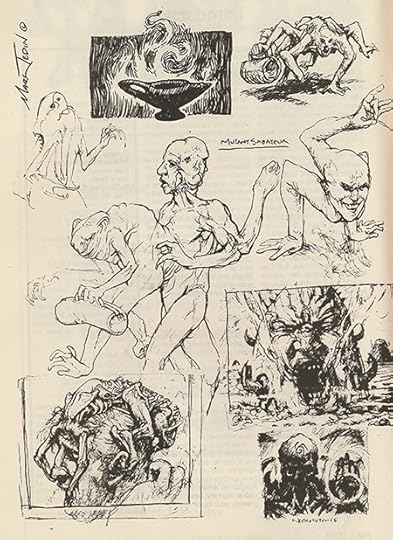
(Concept sketches for several of Tedin’s most famous cards.)
Even in 1996, there was a debate in the artistic community about traditional versus digital work. “You can always tell that it is digital,” Tedin says, though he admits that he likes the flexibility of working digitally.
Finally, there’s the thorny topic of the (then) new flat fee policy for artwork that Wizards of the Coast was implementing at the time. Almost every artist interviewed expressed their disappointment with the policy. What surprised me personally was the candor with which the artists and Tice spoke about the topic. The universal opinion seemed to be that Wizards had fostered a very creator-friendly environment with its royalty system that could have served as a model for the rest of the industry. With the flat fee policy, WOTC was reneging on an agreement made “a long time ago.” I’ll let others debate what this would have meant for Magic’s ultimate survival and profitability.
Translating Magic (pages 11-12): In this interview, Hanno Girke and Bernd Bolzenius talk about the challenges and rewards of translating Magic into German.
For example, when Phasing was introduced during Mirage, the ability gave translators a hard time. “We didn’t want to use the word ‘Phase.’ In German, this name was prone to confuse a new player with the phase system in Magic, so we chose ‘Instabilität,’” Girke and Bolzenius explain.
They also reveal that the German Revised printings of Verduran Enchantress and Dwarven Weaponsmith had amusing errors. In German, the Enchantress let you draw a card for any spell cast, while the Weaponsmith let you put +1/+1 counters on all your creatures.
Lastly, there is the topic of proper nouns. Girke and Bolzenius explain that names are kept unless they become very difficult to understand in German and/or mean something else in the language. Sometimes, though, they get to localize names in fun ways. For example, the translators drew on the tradition of German mythology to rename Winter Orb as Frostbringer.
Phil Foglio (pages 13-17): Phil Foglio’s interview doesn’t cover much new ground that hasn’t already been covered by writers over the past 20+ years. Even in 1996, Phil was a “controversial” illustrator for the game, since his style was so different from many of the other artists. That many of his images were humorous as well didn’t sit right with some players.
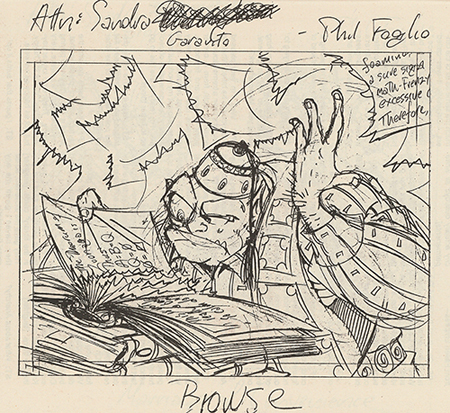
(The concept sketch for Browse, addressed to then-Art Director Sandra Everingham.)
Phil addresses these criticisms in the interview, usually with a joke. To those who dislike his art for Presence of the Master, for instance, one of Phil’s responses is, “Tough!”
A lot of the interview is dedicated to the XXXenophile card game that Phil was developing at the time with James Ernest. Though the game clearly failed to catch on, Phil’s comic on which it is based remains a cult hit among indie comic fans.
Kaja Foglio (pages 18-25): Unlike her husband’s interview, Kaja Foglio’s piece offers a few more insights for Magic fans. Kaja’s career has always been tied closely to Phil’s, and this is something that has caused an internal conflict for her. “[M]y stuff was being compared to his. Nobody likes that, nobody likes to be thought of as derivative. So I’ve been trying to go in another direction, just to get away from that,” she says.
Kaja notes that she was very influenced by Wendy Pini of Elfquest fame and that Magic was her first professional job. She also says that Wizards of the Coast was going to start letting artists make larger paintings, so the company must have been in the process of buying a new scanner that was larger than 5.5 inches.
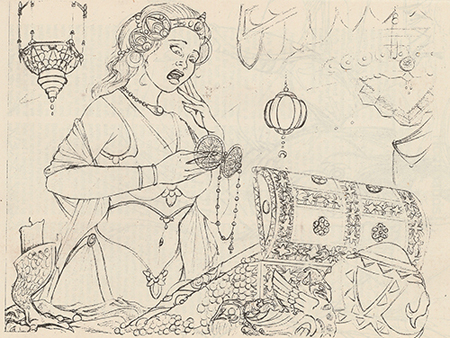
(Initial sketch for Amulet of Unmaking.)
It’s also amusing to hear stories about individual cards. For example, Kaja has no idea why the individual on the right in Cuombajj Witches has six fingers. Nor was she satisfied with the art for Millstone, which became a rather iconic image from the early days of Magic and was used up until Seventh Edition.
Homelands (pages 26-31): In this interview, Kyle Namvar and Scott Hungerford talk about the Homeland expansion, with input from Pete Venters, who was in charge of story continuity at the time.
Tice writes in his introduction that the Homelands expansion was controversial from the start because it had an incredibly detailed story but uneven play quality. Hungerford confirms they wanted to make an easy-to-play set aimed at a younger audience that could potentially “screw with that hardcore player.” There were also, according to Namvar, about 75 high-powered cards that were cut from the set. These included a land that could imitate any other land in play and an elf tribal counterpart to Didgeridoo!

(An unpublished sketch of Baron Sengir by Pete Venters.)
Here are some notable lore bits mentioned in the article:
* The storyworld matter for Homelands grew to 180 pages before the R&D final review. This included “a particularly vital Denny’s restaurant placemat covered with cryptic scribbling,” according to Hungerford.
* The pearls needed to make Mox Pearl artifacts come from Giant Oysters. Reveka, head of the Wizards’ School, supposedly possesses books that contain this knowledge.
* Hungerford’s explanation of the Timmerian Fiends ante card is interesting because it mentions that the fiends live in the Æther and can momentarily break into our reality to steal things they want.
* Feroz was gifted at clockwork magic, which makes sense because he was disdainful of calling creatures to his aid in duels.
Susan Van Camp (pages 32-35): The interview with artist Susan Van Camp focuses heavily on Dragon Storm, the role-playing/card game hybrid that she was working on at the time. Van Camp designed the game with some input from her husband, and it was released in 1996. Several original Magic artists contributed to it.
Van Camp describes the game as a role-playing experience for adults who don’t have much time to game and newcomers who are intimidated by the complex rules of games like Dungeons & Dragons. The goal of Dragon Storm was to make role-playing accessible and fun.
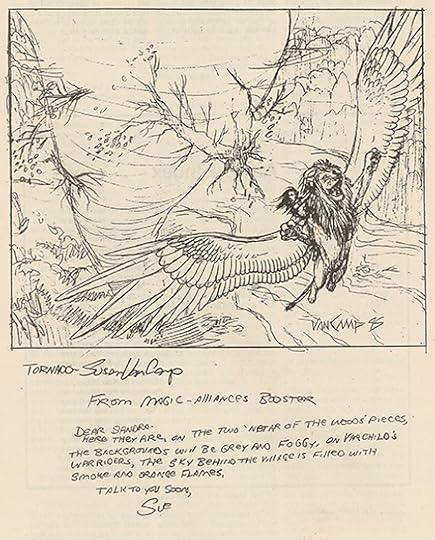
(The concept sketch for Tornado with a note from who I assume is Sue Ann Harkey.)
There aren’t many revelations in regards to Van Camp’s Magic work, but there is one interesting lore bit. Tice asks why Veldrane of Sengir and the Faerie Noble look so alike. An editor’s note with a quote from Scott Hungerford explains the resemblance: “Veldrane had been invading the Great Wood on a regular basis for some time, and when the Autumn Willow made a Host of Faeries specifically to stop him, she made the leader of the Fae Host look just like Veldrane as a sort of practical joke at Veldrane’s expense. Imagine his surprise at being forced to fight a small army led by an exact fae-sized replica of himself! Sort of a natural justice, eh?”
Alliances (pages 36-41): Like the Homelands article, this piece is an interview with Skaff Elias, Jim Lin, Mark Rosewater, Scott Hungerford, and Pete Venters about the Alliances expansion.
A lot of the article is devoted to how Alliances was designed. A “major transition” within R&D meant that the team had more playtest time than usual. In fact, the eight month gap between Homelands and Alliances is the longest gap between expansions in the game’s history. Alliances was also, I believe, the first set that Mark Rosewater worked development on.
It’s obvious from the interview that the role of gorillas in the set was a sore spot among those involved. The origin of gorillas in the set was apparently an off-hand comment that became a joke that went too far. Many of the playtest cards in the set carried names like “Nibble of Gorilla,” “Flying Poisonous Gorilla,” “Time Machine of the Apes,” and more. The card Guerilla Tactics was kept as an in-joke.
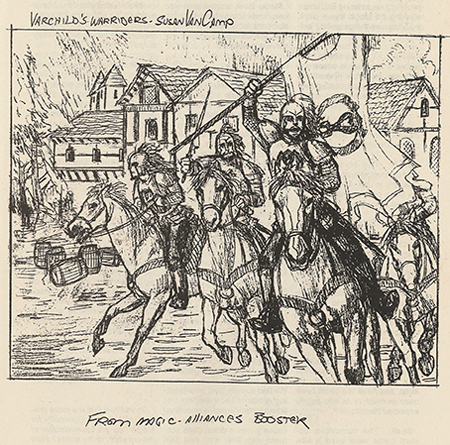
(The sketch for Varchild’s War-Riders by Susan Van Camp.)
There’s also an interesting lore bit about Phelddagrif, everyone’s favorite flying purple hippo. According to Lin and Rosewater, “Phelddagrif” was the original name for Freyalise, who was first conceived as “the goddess of spring in Ice Ace.” Continuity said the name sounded too much like a flying purple hippo. The rest is history.
By the way, Venters states in the interview that the Phelddagrif is a mythical creature from a children’s story on Terisiare and that summoning them is like calling to a “magical construct” rather than a real creature.
Finally, there are some interesting notes about how the story was (or, in this case, wasn’t) developed for Alliances. Venters explains that the cards were created before the story, which meant that “retro-fitting and shaping the story to match the needs of the card set” occurred. While there was a skeleton of a story in place, it was written by John Tynes as he was leaving the company and taken up by Venters and Hungerford as the set developed.
Ken Meyer Jr. (pages 42-47): The interview with Ken Meyer Jr. is a nice change of pace because it focuses a tight lens on his comic work. Meyer was working on a number of independent comics at the time for Caliber, as well as mainstream titles for Marvel. “Check out things that aren’t Marvel or DC or Image, or even, say, Dark Horse,” Meyer advises. “There are so many self-published comics out there that are really good.”

(A sketch for Erhnam Djinn with notes by the artist.)
On the Magic side, Meyer talks about his cards for Arabian Nights and Ice Age. The illustration on Kird Ape, he says, is based on a photo from National Geograph and can even be found in the magazine (though he doesn’t specify which issue). He also says he has an easier time doing cards that include figures rather than ones with abstract spells. This is because Meyer feels that he relys too much on photo references — something I found particularly interesting since these are a vital tool for many artists. “I don’t draw out of my head as well as I should,” Meyer says.
Mirage (pages 48-50): For the third set-based interview of the issue, Tice speaks to Joel Mick, Bill Rose, Mark Rosewater, and Pete Venters about Mirage, which was the newest MTG expansion at the time.
Unfortunately, the article is rather short and doesn’t include many details. On the design side, Mirage introduced the Flanking and Phasing mechanics. It was also a concerted attempt to introduce diversity into a game that Venters describes as “becoming rather too heavily Caucasian.”
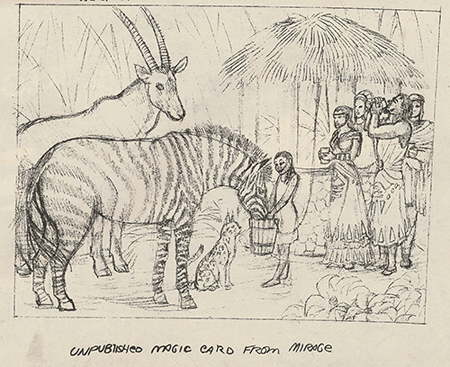
(Wellspring by Susan Van Camp. The handwritten note says the art was unused, but the card did appear in the set.)
On the lore side, Venters talks about Teferi and the five guilds of Jamuraa. He also erroneously describes the location of Jamuraa as being in the “extreme northwest … a series of tropical continents.” Finally, Venters mentions that residents of the plane Rabiah settled on Jamuraa. We know that they came to Dominaria through a planar portal.
Richard Garfield (page 51): This interview with Richard Garfield is particularly short, comprising only six questions. Among the insights here are that his favorite expansions to date were Ice Age and Alliances and that Wall of Ice is a green card (rather than blue) because it is meant to be a force of nature or nature itself.
Pete Venters (pages 52-57): Pete Venters contributed a tremendous amount of information to the Musings Magic Special, so it’s fitting that the final interview of the issue is an extensive one-on-one with him.
The content of the interview falls roughly into two sections: information about Venters’ role as an artist and details about his job as continuity coordinator for Wizards of the Coast.
On the art side, Venters says it takes him 10-30 hours to do a painting. He’s the first and only artist in the issue to put numbers around his artistic work. This is interesting to me because it gives non-artists an insight into how long art takes to create. Put another way for someone who works a 9-5 job, one painting can take between one and five normal work days. Except Venters was doing it at night because of his day job at WOTC.
Venters also talks about his brief foray into comics and his comic book influences. He says he felt he didn’t make it in comics because he didn’t like the unrealistic anatomy of the superhero genre. He also says, “I despise a lot of the tripe that poses as current modern art.”
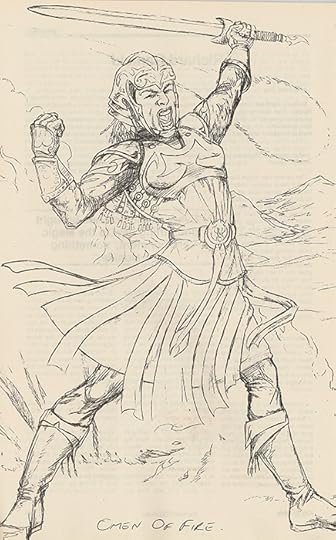
(The full-body sketch for Omen of Fire.)
On the continuity coordinator side, Venters describes his whole job role, which included the creation of card set back story (and being able to answer on-demand questions about those stories); aiding in the creation of final card names and flavor text; helping translators localize card text; drawing maps; and concept work on the look of MTG cultures. He notes that he is working on a map of Jamuraa and is “80 percent done” with the famous black-and-white globe of Dominaria, which factored heavily in the creation of 2018’s Dominaria set. When Tice asks if players will be able to get a map of Dominaria soon, Venters replies that he hopes to have the globe transferred into a wall map by 1997. As it turns out, it would take 21 more years for this to actually happen.
At the time, Venters was also working on something called “the Magic Database.” At first, I thought this might be an early version of the Gatherer card search engine. But a note on the MTG Wiki gives me pause. Venters describes the database as containing “additional story info not yet seen in publication.” This jives more closely with “Multiverse,” the in-house R&D database now called “Drake.” There’s also mention of Encyclopedia Dominia, an early lore website.
Finally, and as one would expect from a continuity coordinator, there are a few lore insights:
* Baron Sengir’s style of dress hints at where he came from before landing in Ulgrotha.
* If Ravi / Grandmother Sengir was a Planeswalker, she lost her spark when she rang the Apocalypse Chime.
* Omen of Fire is a portrait of General Varchild. Apart from the actual play mechanics, Venters designed everything about the card — character, card title, art, and flavor text.
World Decks (pages 58-63): The final article in the Musings Magic Special is about a play format invented by Tice called “World Decks.” I’m not going to spend a lot of time on this piece because the game type is unworkable today for a number of reasons and has been eclipsed by other casual and sanctioned formats.
With World Decks, Tice wanted to “mimic the random generation tables of the role-playing game Dungeons and Dragons.” This involved creating several 1,000-card decks — yes, 1,000 — focused around three colors to utilize as many printed cards as possible.
Tice talks about card selection, rules, game play, and the strengths and weaknesses of the format. But with more than 20,000 unique cards available today, World Decks would likely be impossible to play.
That doesn’t mean players haven’t found ways to play with some of the game’s less popular cards. Elder Dragon Highlander (EDH), now called Commander, emerged at roughly the same time and has grown to become a sanctioned format. Likewise, cube drafts are a popular casual format in which players create their own draft environment.
Calliope Comics in Pennsylvania is a comic and game store run by Steven Tice. In the mid-1990s, the store published a “comic book literary magazine” called Musings. Each issue focused on a specific creator and included articles, essays, and interviews.
After covering such luminaries as Neil Gaiman, Todd McFarlane, and Mike Mignolia, Musings turned its attention to Magic: The Gathering. In the fall of 1996, Calliope published the Musings Magic Special. This was one of the last Magic “comics” to be published before Dark Horse acquired the license to produce Gerard’s Quest about three years later.
In addition to featuring interviews with some of the game’s biggest artists, the Musings Magic Special also included stories about translators, set designers, and even Magic’s creator, Richard Garfield. Best of all, the issue included lots of art, including preliminary concepts for some of Magic’s early expansions.
Unlike Convocations — A Magic: The Gathering Gallery, the Musings Magic Special featured some lore tidbits, especially in the interviews with set creators. I can’t speculate on the canonical status of these lore nuggets since (a.) they were all published pre-revision and (b.) occur in interviews instead of stories. However, I will share what’s here regardless.
In sum, the Musings Magic Special provides a fascinating look behind the curtain at how the game was made, both from a visual and written storytelling perspective. Examining the issue today offers a singular time capsule into Magic’s early success and how it became — and remains — one of the most popular games in the world.


(The front and rear covers, by Mark Tedin.)
CONTENT
For this review, I’ll once again be skipping the regular sections. Instead I want to look at every article and provide some notes about each. Steven Tice was kind enough to grant permission to reprint some of the sketches that appeared in the Musings Magic Special. The copyright for all text and images belongs to their respective creators and intellectual property holders.
Mark Tedin (pages 2-10): The interview with Mark Tedin delves into his personal creative process and what the art assignments were like in the early days of Magic. He explains, “[G]enerally, they just give me the title of the card, like ‘Horror of Horrors’ or ‘Mutant Saboteur’ (which was later renamed ‘Mindstab Thrull’), but they don’t give any more information unless requested, which I think is good because it frees me to come up with whatever concept I like.”
Tedin reveals that he disliked the art for Nevinyrral's Disk; that Chaos Orb was partially inspired by the film Zardoz; and that the idea for Feldon’s Cane came to him after he saw surgical instruments for replacing joints.

(Concept sketches for several of Tedin’s most famous cards.)
Even in 1996, there was a debate in the artistic community about traditional versus digital work. “You can always tell that it is digital,” Tedin says, though he admits that he likes the flexibility of working digitally.
Finally, there’s the thorny topic of the (then) new flat fee policy for artwork that Wizards of the Coast was implementing at the time. Almost every artist interviewed expressed their disappointment with the policy. What surprised me personally was the candor with which the artists and Tice spoke about the topic. The universal opinion seemed to be that Wizards had fostered a very creator-friendly environment with its royalty system that could have served as a model for the rest of the industry. With the flat fee policy, WOTC was reneging on an agreement made “a long time ago.” I’ll let others debate what this would have meant for Magic’s ultimate survival and profitability.
Translating Magic (pages 11-12): In this interview, Hanno Girke and Bernd Bolzenius talk about the challenges and rewards of translating Magic into German.
For example, when Phasing was introduced during Mirage, the ability gave translators a hard time. “We didn’t want to use the word ‘Phase.’ In German, this name was prone to confuse a new player with the phase system in Magic, so we chose ‘Instabilität,’” Girke and Bolzenius explain.
They also reveal that the German Revised printings of Verduran Enchantress and Dwarven Weaponsmith had amusing errors. In German, the Enchantress let you draw a card for any spell cast, while the Weaponsmith let you put +1/+1 counters on all your creatures.
Lastly, there is the topic of proper nouns. Girke and Bolzenius explain that names are kept unless they become very difficult to understand in German and/or mean something else in the language. Sometimes, though, they get to localize names in fun ways. For example, the translators drew on the tradition of German mythology to rename Winter Orb as Frostbringer.
Phil Foglio (pages 13-17): Phil Foglio’s interview doesn’t cover much new ground that hasn’t already been covered by writers over the past 20+ years. Even in 1996, Phil was a “controversial” illustrator for the game, since his style was so different from many of the other artists. That many of his images were humorous as well didn’t sit right with some players.

(The concept sketch for Browse, addressed to then-Art Director Sandra Everingham.)
Phil addresses these criticisms in the interview, usually with a joke. To those who dislike his art for Presence of the Master, for instance, one of Phil’s responses is, “Tough!”
A lot of the interview is dedicated to the XXXenophile card game that Phil was developing at the time with James Ernest. Though the game clearly failed to catch on, Phil’s comic on which it is based remains a cult hit among indie comic fans.
Kaja Foglio (pages 18-25): Unlike her husband’s interview, Kaja Foglio’s piece offers a few more insights for Magic fans. Kaja’s career has always been tied closely to Phil’s, and this is something that has caused an internal conflict for her. “[M]y stuff was being compared to his. Nobody likes that, nobody likes to be thought of as derivative. So I’ve been trying to go in another direction, just to get away from that,” she says.
Kaja notes that she was very influenced by Wendy Pini of Elfquest fame and that Magic was her first professional job. She also says that Wizards of the Coast was going to start letting artists make larger paintings, so the company must have been in the process of buying a new scanner that was larger than 5.5 inches.

(Initial sketch for Amulet of Unmaking.)
It’s also amusing to hear stories about individual cards. For example, Kaja has no idea why the individual on the right in Cuombajj Witches has six fingers. Nor was she satisfied with the art for Millstone, which became a rather iconic image from the early days of Magic and was used up until Seventh Edition.
Homelands (pages 26-31): In this interview, Kyle Namvar and Scott Hungerford talk about the Homeland expansion, with input from Pete Venters, who was in charge of story continuity at the time.
Tice writes in his introduction that the Homelands expansion was controversial from the start because it had an incredibly detailed story but uneven play quality. Hungerford confirms they wanted to make an easy-to-play set aimed at a younger audience that could potentially “screw with that hardcore player.” There were also, according to Namvar, about 75 high-powered cards that were cut from the set. These included a land that could imitate any other land in play and an elf tribal counterpart to Didgeridoo!

(An unpublished sketch of Baron Sengir by Pete Venters.)
Here are some notable lore bits mentioned in the article:
* The storyworld matter for Homelands grew to 180 pages before the R&D final review. This included “a particularly vital Denny’s restaurant placemat covered with cryptic scribbling,” according to Hungerford.
* The pearls needed to make Mox Pearl artifacts come from Giant Oysters. Reveka, head of the Wizards’ School, supposedly possesses books that contain this knowledge.
* Hungerford’s explanation of the Timmerian Fiends ante card is interesting because it mentions that the fiends live in the Æther and can momentarily break into our reality to steal things they want.
* Feroz was gifted at clockwork magic, which makes sense because he was disdainful of calling creatures to his aid in duels.
Susan Van Camp (pages 32-35): The interview with artist Susan Van Camp focuses heavily on Dragon Storm, the role-playing/card game hybrid that she was working on at the time. Van Camp designed the game with some input from her husband, and it was released in 1996. Several original Magic artists contributed to it.
Van Camp describes the game as a role-playing experience for adults who don’t have much time to game and newcomers who are intimidated by the complex rules of games like Dungeons & Dragons. The goal of Dragon Storm was to make role-playing accessible and fun.

(The concept sketch for Tornado with a note from who I assume is Sue Ann Harkey.)
There aren’t many revelations in regards to Van Camp’s Magic work, but there is one interesting lore bit. Tice asks why Veldrane of Sengir and the Faerie Noble look so alike. An editor’s note with a quote from Scott Hungerford explains the resemblance: “Veldrane had been invading the Great Wood on a regular basis for some time, and when the Autumn Willow made a Host of Faeries specifically to stop him, she made the leader of the Fae Host look just like Veldrane as a sort of practical joke at Veldrane’s expense. Imagine his surprise at being forced to fight a small army led by an exact fae-sized replica of himself! Sort of a natural justice, eh?”
Alliances (pages 36-41): Like the Homelands article, this piece is an interview with Skaff Elias, Jim Lin, Mark Rosewater, Scott Hungerford, and Pete Venters about the Alliances expansion.
A lot of the article is devoted to how Alliances was designed. A “major transition” within R&D meant that the team had more playtest time than usual. In fact, the eight month gap between Homelands and Alliances is the longest gap between expansions in the game’s history. Alliances was also, I believe, the first set that Mark Rosewater worked development on.
It’s obvious from the interview that the role of gorillas in the set was a sore spot among those involved. The origin of gorillas in the set was apparently an off-hand comment that became a joke that went too far. Many of the playtest cards in the set carried names like “Nibble of Gorilla,” “Flying Poisonous Gorilla,” “Time Machine of the Apes,” and more. The card Guerilla Tactics was kept as an in-joke.

(The sketch for Varchild’s War-Riders by Susan Van Camp.)
There’s also an interesting lore bit about Phelddagrif, everyone’s favorite flying purple hippo. According to Lin and Rosewater, “Phelddagrif” was the original name for Freyalise, who was first conceived as “the goddess of spring in Ice Ace.” Continuity said the name sounded too much like a flying purple hippo. The rest is history.
By the way, Venters states in the interview that the Phelddagrif is a mythical creature from a children’s story on Terisiare and that summoning them is like calling to a “magical construct” rather than a real creature.
Finally, there are some interesting notes about how the story was (or, in this case, wasn’t) developed for Alliances. Venters explains that the cards were created before the story, which meant that “retro-fitting and shaping the story to match the needs of the card set” occurred. While there was a skeleton of a story in place, it was written by John Tynes as he was leaving the company and taken up by Venters and Hungerford as the set developed.
Ken Meyer Jr. (pages 42-47): The interview with Ken Meyer Jr. is a nice change of pace because it focuses a tight lens on his comic work. Meyer was working on a number of independent comics at the time for Caliber, as well as mainstream titles for Marvel. “Check out things that aren’t Marvel or DC or Image, or even, say, Dark Horse,” Meyer advises. “There are so many self-published comics out there that are really good.”

(A sketch for Erhnam Djinn with notes by the artist.)
On the Magic side, Meyer talks about his cards for Arabian Nights and Ice Age. The illustration on Kird Ape, he says, is based on a photo from National Geograph and can even be found in the magazine (though he doesn’t specify which issue). He also says he has an easier time doing cards that include figures rather than ones with abstract spells. This is because Meyer feels that he relys too much on photo references — something I found particularly interesting since these are a vital tool for many artists. “I don’t draw out of my head as well as I should,” Meyer says.
Mirage (pages 48-50): For the third set-based interview of the issue, Tice speaks to Joel Mick, Bill Rose, Mark Rosewater, and Pete Venters about Mirage, which was the newest MTG expansion at the time.
Unfortunately, the article is rather short and doesn’t include many details. On the design side, Mirage introduced the Flanking and Phasing mechanics. It was also a concerted attempt to introduce diversity into a game that Venters describes as “becoming rather too heavily Caucasian.”

(Wellspring by Susan Van Camp. The handwritten note says the art was unused, but the card did appear in the set.)
On the lore side, Venters talks about Teferi and the five guilds of Jamuraa. He also erroneously describes the location of Jamuraa as being in the “extreme northwest … a series of tropical continents.” Finally, Venters mentions that residents of the plane Rabiah settled on Jamuraa. We know that they came to Dominaria through a planar portal.
Richard Garfield (page 51): This interview with Richard Garfield is particularly short, comprising only six questions. Among the insights here are that his favorite expansions to date were Ice Age and Alliances and that Wall of Ice is a green card (rather than blue) because it is meant to be a force of nature or nature itself.
Pete Venters (pages 52-57): Pete Venters contributed a tremendous amount of information to the Musings Magic Special, so it’s fitting that the final interview of the issue is an extensive one-on-one with him.
The content of the interview falls roughly into two sections: information about Venters’ role as an artist and details about his job as continuity coordinator for Wizards of the Coast.
On the art side, Venters says it takes him 10-30 hours to do a painting. He’s the first and only artist in the issue to put numbers around his artistic work. This is interesting to me because it gives non-artists an insight into how long art takes to create. Put another way for someone who works a 9-5 job, one painting can take between one and five normal work days. Except Venters was doing it at night because of his day job at WOTC.
Venters also talks about his brief foray into comics and his comic book influences. He says he felt he didn’t make it in comics because he didn’t like the unrealistic anatomy of the superhero genre. He also says, “I despise a lot of the tripe that poses as current modern art.”

(The full-body sketch for Omen of Fire.)
On the continuity coordinator side, Venters describes his whole job role, which included the creation of card set back story (and being able to answer on-demand questions about those stories); aiding in the creation of final card names and flavor text; helping translators localize card text; drawing maps; and concept work on the look of MTG cultures. He notes that he is working on a map of Jamuraa and is “80 percent done” with the famous black-and-white globe of Dominaria, which factored heavily in the creation of 2018’s Dominaria set. When Tice asks if players will be able to get a map of Dominaria soon, Venters replies that he hopes to have the globe transferred into a wall map by 1997. As it turns out, it would take 21 more years for this to actually happen.
At the time, Venters was also working on something called “the Magic Database.” At first, I thought this might be an early version of the Gatherer card search engine. But a note on the MTG Wiki gives me pause. Venters describes the database as containing “additional story info not yet seen in publication.” This jives more closely with “Multiverse,” the in-house R&D database now called “Drake.” There’s also mention of Encyclopedia Dominia, an early lore website.
Finally, and as one would expect from a continuity coordinator, there are a few lore insights:
* Baron Sengir’s style of dress hints at where he came from before landing in Ulgrotha.
* If Ravi / Grandmother Sengir was a Planeswalker, she lost her spark when she rang the Apocalypse Chime.
* Omen of Fire is a portrait of General Varchild. Apart from the actual play mechanics, Venters designed everything about the card — character, card title, art, and flavor text.
World Decks (pages 58-63): The final article in the Musings Magic Special is about a play format invented by Tice called “World Decks.” I’m not going to spend a lot of time on this piece because the game type is unworkable today for a number of reasons and has been eclipsed by other casual and sanctioned formats.
With World Decks, Tice wanted to “mimic the random generation tables of the role-playing game Dungeons and Dragons.” This involved creating several 1,000-card decks — yes, 1,000 — focused around three colors to utilize as many printed cards as possible.
Tice talks about card selection, rules, game play, and the strengths and weaknesses of the format. But with more than 20,000 unique cards available today, World Decks would likely be impossible to play.
That doesn’t mean players haven’t found ways to play with some of the game’s less popular cards. Elder Dragon Highlander (EDH), now called Commander, emerged at roughly the same time and has grown to become a sanctioned format. Likewise, cube drafts are a popular casual format in which players create their own draft environment.
Published on June 27, 2018 17:50
•
Tags:
comic-books, comics, magic-the-gathering, mtg, wizards-of-the-coast, wotc
May 6, 2018
Guest Blog: Interview with Suzanne Helmigh on Caldyra
On April 19, Suzanne Helmigh launched a Kickstarter campaign to fund her illustrated fantasy novel Caldyra, the first in a planned trilogy of books. The project was funded in just 27 hours and is now building toward various stretch goals.
I was familiar with Suzanne from her work on Magic: The Gathering. When I saw that she was working on not only a fantasy novel, but a fully illustrated and immersive one, I wanted to learn more about the project.
Hailing from the Netherlands, Suzanne is a professional concept artist and illustrator. She has a degree in film and animation, and had worked on games like Magic: The Gathering and Horizon Zero Dawn. She has a passion for worldbuilding and counts Star Wars, Indiana Jones, and Jurassic Park among her biggest influences.

Pat: As a fellow writer, I’m always interested to hear about an author’s publishing journey. With so many options out there — self-publishing, indie publishing, traditional publishing — why did you decide on Kickstarter as your publishing avenue?
Suzanne: Being an experienced artist, yet fairly new to writing, I am under the impression that most publishers would not take the risk of accepting someone’s first book. I personally feel like, if I can publish it myself and have proof that I have a good story to tell, I can later pitch new stories to other publishers. I’ve actually had some publishers approach me with offers, but they seemed rather outrageous when it came to the revenue I would earn for myself. Kickstarter feels much more personal and keeps me in control.
Pat: You’ve been working on Caldyra for some time, first as an illustration project and then as a full-on narrative story. How did the idea come about?
Suzanne: Caldyra started off as a distraction. I would work normal office hours at a game studio on golf and Candy Crush-like games, which are soul-killing subjects for those who like to create worlds. So, whenever I came home I would slowly build scenes, situations, dialogues, faces, outfits, personalities, mannerisms. Locations, etc. The more I built, the more it turned into a set of four stories, intertwining with one another.
My first few drafts were horrible. I simply started writing with an idea in mind, from beginning to end. Yet, every time I would bump into problems: the story would get stale or boring, or there would be continuity issues. I realized that even though I graduated from film school with a focus on screenplay writing, my actual writing sucked. I became obsessed with learning books about writing fictional stories. One stuck in particular: Randy Ingermanson’s How to Write a Novel Using the Snowflake Method. I recommend it to everyone who writes!

Pat: Can you tell us what “Caldyra” means and how you came up with the term?
Suzanne: Caldyra comes from caldera, which is the word for the formation that results from a lava eruption. So, that circular shape you see in volcanos is called a caldera.
In my book, Caldyra is a deity that consists of two sky wyrms that share a single consciousness. At some point in the legend, one of them crashes down to the earth, creating volcanoes on impact. The volcanoes erupt and devastate the land, after which it prospers by a hundredfold, spawning magical trees. The remainder of people that survived the previous volcanic devastation are now empowered with magical abilities, which they harvest from those trees.
This took place centuries before my book begins. The book itself starts just after a global war on the last remnants of Caldyra trees. People suddenly have to live again without any magical abilities. The age of Caldyra is seen as passed, but not everyone is so keen to give up on it.
Pat: You have a number of guest artists assisting with Caldyra. What role will they play in helping you tell the story?
Suzanne: They will mainly help with the images that I’ll use to open every chapter. In contrast with the rest of my book, where I aim for a realistic cinematic feel, these chapter openers are meant to be symbolic and very artistic.
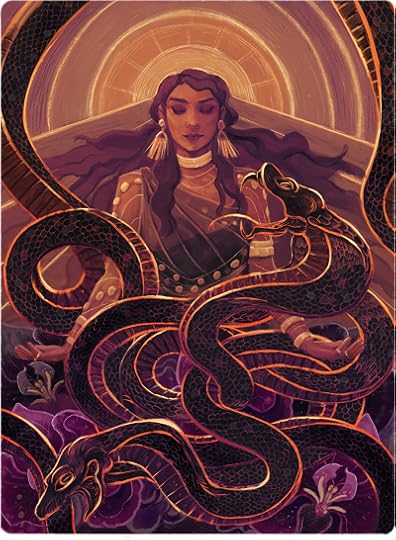
(One of the chapter openers by guest artist Amagoia Agirre.)
Pat: Writers can be notorious procrastinators (myself included). What has it been like pulling double-duty as writer and artist on this project?
Suzanne: I think my personality traits that come with being a concept artist and illustrator have pushed away the urge to procrastinate. I used to procrastinate a lot actually, before this project. But I turned my thoughts towards becoming my own drill sergeant and am much more likely to work myself to death than to wait things out.
I’ve spent years working 16 hours a day for both clients and my own projects, to an extent where I find it pretty hard to relax and enjoy the sun or a game. I always try and find tasks that I consider hard. Writing is hard because I have a strong case of dyslexia (but don’t worry, I’ve created my book in collaboration with an editor). Painting crazy staircases: hard? Let’s make two. Painting crowds of people: hard? Yup, let’s make at least three of those!
Pat: I’d like to pivot for a moment to your work on Magic: The Gathering. You recently joined the MTG art community and provided art for the last two sets. How did you get started with Magic?
Suzanne: It’s a funny story. There’s an art website called Deviantart, where I have my roots like many other artists. On that website people know me less for my art than for my artist blog posts, which can get more than 300,000 unique reads. One blog post in particular was about my ambition to work on Magic: The Gathering and my three-year plan to work on my portfolio in order to make it happen.
One of the art directors back then (already in 2016) read that post and actually contacted me right after, giving me feedback and inviting me to mail him updates of my progress. Half a year later, after a few back and forths, I received the email I had been dreaming of: “Suzanne, welcome to the Magic artist team!”
It’s fair to say I did a couple of silly dances in my office and celebrated by eating cake.
Pat: What has been your favorite card to work on so far?
Suzanne: My favorite card has not been released yet, as all these sets get commissioned a bit more than a year in advance! But my favorite one that is out must be Radiating Lightning. I am a sucker for painting groups of people, especially where I can work on their body language and facial expressions.
My favorite card to play with that I worked on is by far is Rat Colony. Oooh how I’m going to wreck some fields with that!

(Radiating Lightning for Magic: The Gathering.)
Pat: I always love hearing that MTG artists also enjoy the game themselves! What formats do you play?
Suzanne: I love EDH, drafting whenever there is a new set, cube (we own a fantastic one, with a custom-made wooden box!), and just homebrew.
Pat: And will fans continue to see your work in future Magic sets? How about any other games you’re currently working on?
Suzanne: Yes! I am still doing some Magic cards here and there. I have also done some work for a new card game called Artifact that Valve is releasing, as have many other MTG artists. [Author’s note: Artifact was designed by Magic: The Gathering creator Richard Garfield and is expected to release sometime this year.]
Pat: Finally, I know you have an interest in Historical European Martial Arts, also known as HEMA. Will you be serving as a fight coordinator when the inevitable Caldyra film adaptation occurs?
Suzanne: Hahaha, I think that job is far better suited to some crazy cool martial arts choreographers in Hollywood. Not that I even dare dream of a film adaptation of my story!
Funny enough, fighting in movies is never ever accurate in the slightest. That is because they use impractical moves that look cool and big, but that make you incredibly slow. The HEMA group I train with is also specialized in show-fighting, so we learn to do both and spot the difference!
To learn more about Caldyra, back the campaign, or read a sample chapter, visit caldyra.com.
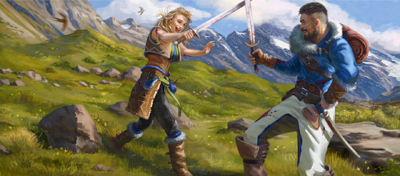
I was familiar with Suzanne from her work on Magic: The Gathering. When I saw that she was working on not only a fantasy novel, but a fully illustrated and immersive one, I wanted to learn more about the project.
Hailing from the Netherlands, Suzanne is a professional concept artist and illustrator. She has a degree in film and animation, and had worked on games like Magic: The Gathering and Horizon Zero Dawn. She has a passion for worldbuilding and counts Star Wars, Indiana Jones, and Jurassic Park among her biggest influences.

Pat: As a fellow writer, I’m always interested to hear about an author’s publishing journey. With so many options out there — self-publishing, indie publishing, traditional publishing — why did you decide on Kickstarter as your publishing avenue?
Suzanne: Being an experienced artist, yet fairly new to writing, I am under the impression that most publishers would not take the risk of accepting someone’s first book. I personally feel like, if I can publish it myself and have proof that I have a good story to tell, I can later pitch new stories to other publishers. I’ve actually had some publishers approach me with offers, but they seemed rather outrageous when it came to the revenue I would earn for myself. Kickstarter feels much more personal and keeps me in control.
Pat: You’ve been working on Caldyra for some time, first as an illustration project and then as a full-on narrative story. How did the idea come about?
Suzanne: Caldyra started off as a distraction. I would work normal office hours at a game studio on golf and Candy Crush-like games, which are soul-killing subjects for those who like to create worlds. So, whenever I came home I would slowly build scenes, situations, dialogues, faces, outfits, personalities, mannerisms. Locations, etc. The more I built, the more it turned into a set of four stories, intertwining with one another.
My first few drafts were horrible. I simply started writing with an idea in mind, from beginning to end. Yet, every time I would bump into problems: the story would get stale or boring, or there would be continuity issues. I realized that even though I graduated from film school with a focus on screenplay writing, my actual writing sucked. I became obsessed with learning books about writing fictional stories. One stuck in particular: Randy Ingermanson’s How to Write a Novel Using the Snowflake Method. I recommend it to everyone who writes!

Pat: Can you tell us what “Caldyra” means and how you came up with the term?
Suzanne: Caldyra comes from caldera, which is the word for the formation that results from a lava eruption. So, that circular shape you see in volcanos is called a caldera.
In my book, Caldyra is a deity that consists of two sky wyrms that share a single consciousness. At some point in the legend, one of them crashes down to the earth, creating volcanoes on impact. The volcanoes erupt and devastate the land, after which it prospers by a hundredfold, spawning magical trees. The remainder of people that survived the previous volcanic devastation are now empowered with magical abilities, which they harvest from those trees.
This took place centuries before my book begins. The book itself starts just after a global war on the last remnants of Caldyra trees. People suddenly have to live again without any magical abilities. The age of Caldyra is seen as passed, but not everyone is so keen to give up on it.
Pat: You have a number of guest artists assisting with Caldyra. What role will they play in helping you tell the story?
Suzanne: They will mainly help with the images that I’ll use to open every chapter. In contrast with the rest of my book, where I aim for a realistic cinematic feel, these chapter openers are meant to be symbolic and very artistic.

(One of the chapter openers by guest artist Amagoia Agirre.)
Pat: Writers can be notorious procrastinators (myself included). What has it been like pulling double-duty as writer and artist on this project?
Suzanne: I think my personality traits that come with being a concept artist and illustrator have pushed away the urge to procrastinate. I used to procrastinate a lot actually, before this project. But I turned my thoughts towards becoming my own drill sergeant and am much more likely to work myself to death than to wait things out.
I’ve spent years working 16 hours a day for both clients and my own projects, to an extent where I find it pretty hard to relax and enjoy the sun or a game. I always try and find tasks that I consider hard. Writing is hard because I have a strong case of dyslexia (but don’t worry, I’ve created my book in collaboration with an editor). Painting crazy staircases: hard? Let’s make two. Painting crowds of people: hard? Yup, let’s make at least three of those!
Pat: I’d like to pivot for a moment to your work on Magic: The Gathering. You recently joined the MTG art community and provided art for the last two sets. How did you get started with Magic?
Suzanne: It’s a funny story. There’s an art website called Deviantart, where I have my roots like many other artists. On that website people know me less for my art than for my artist blog posts, which can get more than 300,000 unique reads. One blog post in particular was about my ambition to work on Magic: The Gathering and my three-year plan to work on my portfolio in order to make it happen.
One of the art directors back then (already in 2016) read that post and actually contacted me right after, giving me feedback and inviting me to mail him updates of my progress. Half a year later, after a few back and forths, I received the email I had been dreaming of: “Suzanne, welcome to the Magic artist team!”
It’s fair to say I did a couple of silly dances in my office and celebrated by eating cake.
Pat: What has been your favorite card to work on so far?
Suzanne: My favorite card has not been released yet, as all these sets get commissioned a bit more than a year in advance! But my favorite one that is out must be Radiating Lightning. I am a sucker for painting groups of people, especially where I can work on their body language and facial expressions.
My favorite card to play with that I worked on is by far is Rat Colony. Oooh how I’m going to wreck some fields with that!

(Radiating Lightning for Magic: The Gathering.)
Pat: I always love hearing that MTG artists also enjoy the game themselves! What formats do you play?
Suzanne: I love EDH, drafting whenever there is a new set, cube (we own a fantastic one, with a custom-made wooden box!), and just homebrew.
Pat: And will fans continue to see your work in future Magic sets? How about any other games you’re currently working on?
Suzanne: Yes! I am still doing some Magic cards here and there. I have also done some work for a new card game called Artifact that Valve is releasing, as have many other MTG artists. [Author’s note: Artifact was designed by Magic: The Gathering creator Richard Garfield and is expected to release sometime this year.]
Pat: Finally, I know you have an interest in Historical European Martial Arts, also known as HEMA. Will you be serving as a fight coordinator when the inevitable Caldyra film adaptation occurs?
Suzanne: Hahaha, I think that job is far better suited to some crazy cool martial arts choreographers in Hollywood. Not that I even dare dream of a film adaptation of my story!
Funny enough, fighting in movies is never ever accurate in the slightest. That is because they use impractical moves that look cool and big, but that make you incredibly slow. The HEMA group I train with is also specialized in show-fighting, so we learn to do both and spot the difference!
To learn more about Caldyra, back the campaign, or read a sample chapter, visit caldyra.com.

Published on May 06, 2018 18:09
•
Tags:
art, author-interview, books, fantasy, illustration, interview, publishing
April 5, 2018
MTG Comics Reread: Convocations — A Magic: The Gathering Gallery
This reread entry will be a bit different. That’s because the Armada Comics issue that we’re covering today has nothing to do with MTG lore and everything to do with the game’s artwork. As a result, we’ll be skipping some of the sections you’re used to seeing and instead focusing heavily on the creatives.
In January 1996, Armada released Convocations — A Magic: The Gathering Gallery. There wasn’t a story; it was simply an art book in which artists — many from the game itself — interpreted various card combinations with a piece of artwork. Also included were the covers of Ice Age issue 2 and Wayfarer issue 5 without any text or graphics.
In the back of the book, Shawn Carnes provided information on the card combos that were illustrated. Some, like Channel-Fireball, are immortal. Others, like a five-card combo involving Rocket Launcher and Songs of the Damned, less so.
Many people skip Convocations when reviewing the Armada comic line because it contains no lore. But since one of the stated objectives of this project was to put a spotlight on the creative individuals who brought the comics to life, I felt it was appropriate to include it here.
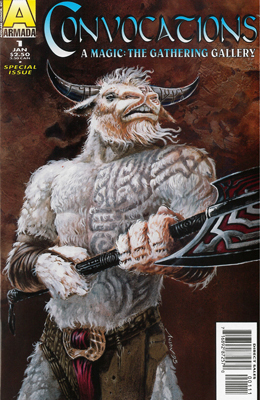
INTRODUCTION
There are those who believe in Magic.
I’m one of them.
I’ve seen it … and now, you will too.
The mystical planes of Dominia are full of all sorts of wondrous magics. You just have to know where to look. Included in these pages are glimpses of some of the fabled wizardry of Dominia. Mythical giants, stalwart heroes, dark villains, wizened mages, and creatures of all shapes and sizes all come together to tell the stories of Magic: The Gathering. Stories you’ve read in series like The Shadow Mage, Ice Age, and Antiquities War, or stories you will be reading such as Elder Dragons, The Legend of Jedit Ojanen, and Homelands.
Culled from the most powerful tomes in Dominia’s vast library, each spell combination depicted in this book uncovers a secret known only to the most learned of mages. Each artist has carefully woven these spells together into the myriad visages you see here.
Guard these secrets well, for they may be the only things that stand between you and magical destruction!
So I ask … do you believe?
– Jeofrey Vita
CREATIVES
Below is an alphabetic list of artists that provided material for Convocations. I have given information about their contributions to Magic: The Gathering and/or other biographical data where available. These are not meant to be exhaustive summaries, nor do they suggest that the careers of these artists were limited strictly to Magic.
Chrysoula Artemis-Gomez: Sorceress Queen / Lightning Bolt / Craw Wurm. Chrysoula is the wife of then-Armada Editor Jeff Gomez. She currently serves as the creative director of Starlight Runner Entertainment, a transmedia company co-founded by Jeff.
Dennis Calero: Birds of Paradise / Regeneration / Instill Energy / Stasis. Calero is a Harvey Award-nominated comic artist who has worked on comics, tie-in products, books, and games. While Calero never produced any card art for Magic: The Gathering, he did work on MTG’s sister property, Dungeons & Dragons. Calero and his wife founded the company Atomic Paintbrush, which was one of the first companies to help comics digitally color, finish, or enhance their panels.
Tobin Dorn: Time Elemental / Ball Lightning. Dorn is the founder of the Tobin Dorn Design Studio, a design management consultancy based out of Southern California that is recognized for its outstanding contributions to the footwear industry. Among his career highlights is designing footwear for films like X-Men and international sporting events.
Michael “Mike” Dringenberg: Braingeyser / Underworld Dreams. Dringenberg did the covers for Arabian Nights issues 1 and 2 and illustrated 41 MTG cards. He is perhaps most famous for co-creating Sandman with Neil Gaiman.
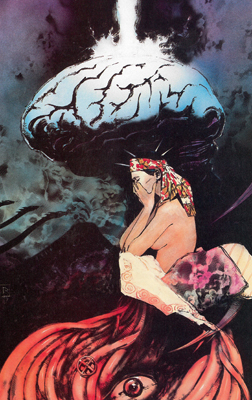
(Braingeyser & Underworld Dreams by Michael “Mike” Dringenberg)
Chris Hebel: War Barge / Merfolk Assassin.
Carlos Phoenix Jimenez: Rukh Egg / Life Chisel. Jimenez is a classically trained illustrator who originally produced freelance sci-fi and fantasy art before moving into marketing, social media, and online content creation. He is also the brand ambassador for the Georgia Latino Film Festival.
Michael Kaluta: Wayfarer issue 5 cover. Kaluta is a decorated comic book artist who has been working in the industry since the 1970s. He is also a Spectrum Award Grand Master. He collaborated with Tony Diterlizzi on three cards for MTG.
Gerard Lee: All Hallow’s Eve / Fallen Angel.
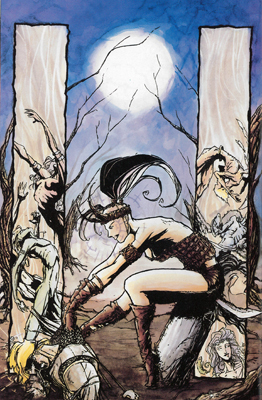
(All Hallow’s Eve & Fallen Angel by Gerard Lee)
Leo Leibelman: Stone Giant / Uthden Troll. Leibelman began his professional career with Marvel before branching out to Valiant and Acclaim. He continues to work in comics and does freelance work for clients like National Geographic and Lucasfilm.
C.R. Lister: Jovial Evil / Heaven’s Gate. Lister was a penciler for Valiant Comics in the 1990s and did at least one piece of concept art for the Ice Age comics.
Anson Maddocks: Convocations cover, plus Fallen Angel / Holy Strength. Maddocks was one of MTG’s original 25 artists and ended up painting 112 game illustrations. His artwork for Hurloon Minotaur became one of the game’s earliest icons.
Alexander Maleev: Sengir Vampire / Farrel’s Mantle. Maleev has worked in comics and advertising since the 1990s. He has provided art for Daredevil, Batman, Spiderwoman, and Star Wars. He worked on the MTG Arabian Nights and Fallen Empires series.
Brad Marshall: Lure / Thicket Basilisk. Marshall is an illustrator and decorated fine artist who today focuses extensively on landscapes.
Jeff Menges: Lure / The Wretched. Menges was one of MTG’s original 25 artists and ended up painting 55 game illustrations. Some of his most famous cards include Bazaar of Baghdad and Swords to Plowshares.
Mark Pennington: White Knight / Mesa Pegasus. Pennington is a career comic artist who has worked for practically every major comic publisher out there. His credits as inker, penciler, and cover artist are longer than my arm.
Doug Shuler: Lord of the Pit / Breeding Pit. Shuler was one of MTG’s original 25 artists and ended up painting 122 game illustrations. Some of his most iconic works for the game include Candelabra of Tawnos and Demonic Tutor.
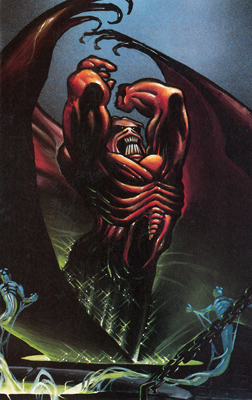
(Lord of the Pit & Breeding Pit by Doug Shuler)
Ron Spencer: Bad Moon / Breeding Pit. Spencer was one of MTG’s original 25 artists and ended up painting more than 230 game illustrations. His sister is fellow MTG artist Terese Nielsen, with whom he collaborated on five pieces in the Shadowmoor set.
Tim Spinosi: Dwarven Warriors / Marsh Viper. Spinosi worked for a number of comic and trading card companies in the 1990s.
Stu Suchit: Lich / Mirror Universe. Suchit was a colorist, inker, penciler, and cover artist for comics in the 1990s. He has since moved into graphic design and works for Stony Brook University in New York.
Juda Tverski: Channel / Fireball. Tverski is a visual artist and designer who operates a wedding video service called JV Weddings out of New York.
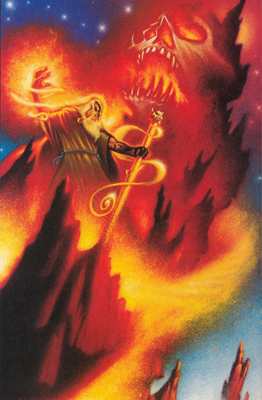
(Channel & Fireball by Juda Tverski)
Pete Venters: Lhurgoyf / Rocket Launcher / Nevinyrral’s Disk / Spoils of Evil / Songs of the Damned. Venters was an early MTG artist who provided more than 280 illustrations for the game. He also served as Magic’s continuity manager from Homelands to Exodus.
Charles Vess: Ice Age issue 2 cover. Vess is a multiple award-winning sci-fi and fantasy artist who has worked in books, comics, and the fine art scene. He’s collaborated with Neil Gaiman and Charles de Lint, and has been the subject of art exhibitions held around the world.
Bryon Wackwitz: Kobold / Blood Lust / Unstable Mutation. Wackwitz was an early MTG artist that provided 21 pieces for the game, including the very famous Angus Mackenzie.
In January 1996, Armada released Convocations — A Magic: The Gathering Gallery. There wasn’t a story; it was simply an art book in which artists — many from the game itself — interpreted various card combinations with a piece of artwork. Also included were the covers of Ice Age issue 2 and Wayfarer issue 5 without any text or graphics.
In the back of the book, Shawn Carnes provided information on the card combos that were illustrated. Some, like Channel-Fireball, are immortal. Others, like a five-card combo involving Rocket Launcher and Songs of the Damned, less so.
Many people skip Convocations when reviewing the Armada comic line because it contains no lore. But since one of the stated objectives of this project was to put a spotlight on the creative individuals who brought the comics to life, I felt it was appropriate to include it here.

INTRODUCTION
There are those who believe in Magic.
I’m one of them.
I’ve seen it … and now, you will too.
The mystical planes of Dominia are full of all sorts of wondrous magics. You just have to know where to look. Included in these pages are glimpses of some of the fabled wizardry of Dominia. Mythical giants, stalwart heroes, dark villains, wizened mages, and creatures of all shapes and sizes all come together to tell the stories of Magic: The Gathering. Stories you’ve read in series like The Shadow Mage, Ice Age, and Antiquities War, or stories you will be reading such as Elder Dragons, The Legend of Jedit Ojanen, and Homelands.
Culled from the most powerful tomes in Dominia’s vast library, each spell combination depicted in this book uncovers a secret known only to the most learned of mages. Each artist has carefully woven these spells together into the myriad visages you see here.
Guard these secrets well, for they may be the only things that stand between you and magical destruction!
So I ask … do you believe?
– Jeofrey Vita
CREATIVES
Below is an alphabetic list of artists that provided material for Convocations. I have given information about their contributions to Magic: The Gathering and/or other biographical data where available. These are not meant to be exhaustive summaries, nor do they suggest that the careers of these artists were limited strictly to Magic.
Chrysoula Artemis-Gomez: Sorceress Queen / Lightning Bolt / Craw Wurm. Chrysoula is the wife of then-Armada Editor Jeff Gomez. She currently serves as the creative director of Starlight Runner Entertainment, a transmedia company co-founded by Jeff.
Dennis Calero: Birds of Paradise / Regeneration / Instill Energy / Stasis. Calero is a Harvey Award-nominated comic artist who has worked on comics, tie-in products, books, and games. While Calero never produced any card art for Magic: The Gathering, he did work on MTG’s sister property, Dungeons & Dragons. Calero and his wife founded the company Atomic Paintbrush, which was one of the first companies to help comics digitally color, finish, or enhance their panels.
Tobin Dorn: Time Elemental / Ball Lightning. Dorn is the founder of the Tobin Dorn Design Studio, a design management consultancy based out of Southern California that is recognized for its outstanding contributions to the footwear industry. Among his career highlights is designing footwear for films like X-Men and international sporting events.
Michael “Mike” Dringenberg: Braingeyser / Underworld Dreams. Dringenberg did the covers for Arabian Nights issues 1 and 2 and illustrated 41 MTG cards. He is perhaps most famous for co-creating Sandman with Neil Gaiman.

(Braingeyser & Underworld Dreams by Michael “Mike” Dringenberg)
Chris Hebel: War Barge / Merfolk Assassin.
Carlos Phoenix Jimenez: Rukh Egg / Life Chisel. Jimenez is a classically trained illustrator who originally produced freelance sci-fi and fantasy art before moving into marketing, social media, and online content creation. He is also the brand ambassador for the Georgia Latino Film Festival.
Michael Kaluta: Wayfarer issue 5 cover. Kaluta is a decorated comic book artist who has been working in the industry since the 1970s. He is also a Spectrum Award Grand Master. He collaborated with Tony Diterlizzi on three cards for MTG.
Gerard Lee: All Hallow’s Eve / Fallen Angel.

(All Hallow’s Eve & Fallen Angel by Gerard Lee)
Leo Leibelman: Stone Giant / Uthden Troll. Leibelman began his professional career with Marvel before branching out to Valiant and Acclaim. He continues to work in comics and does freelance work for clients like National Geographic and Lucasfilm.
C.R. Lister: Jovial Evil / Heaven’s Gate. Lister was a penciler for Valiant Comics in the 1990s and did at least one piece of concept art for the Ice Age comics.
Anson Maddocks: Convocations cover, plus Fallen Angel / Holy Strength. Maddocks was one of MTG’s original 25 artists and ended up painting 112 game illustrations. His artwork for Hurloon Minotaur became one of the game’s earliest icons.
Alexander Maleev: Sengir Vampire / Farrel’s Mantle. Maleev has worked in comics and advertising since the 1990s. He has provided art for Daredevil, Batman, Spiderwoman, and Star Wars. He worked on the MTG Arabian Nights and Fallen Empires series.
Brad Marshall: Lure / Thicket Basilisk. Marshall is an illustrator and decorated fine artist who today focuses extensively on landscapes.
Jeff Menges: Lure / The Wretched. Menges was one of MTG’s original 25 artists and ended up painting 55 game illustrations. Some of his most famous cards include Bazaar of Baghdad and Swords to Plowshares.
Mark Pennington: White Knight / Mesa Pegasus. Pennington is a career comic artist who has worked for practically every major comic publisher out there. His credits as inker, penciler, and cover artist are longer than my arm.
Doug Shuler: Lord of the Pit / Breeding Pit. Shuler was one of MTG’s original 25 artists and ended up painting 122 game illustrations. Some of his most iconic works for the game include Candelabra of Tawnos and Demonic Tutor.

(Lord of the Pit & Breeding Pit by Doug Shuler)
Ron Spencer: Bad Moon / Breeding Pit. Spencer was one of MTG’s original 25 artists and ended up painting more than 230 game illustrations. His sister is fellow MTG artist Terese Nielsen, with whom he collaborated on five pieces in the Shadowmoor set.
Tim Spinosi: Dwarven Warriors / Marsh Viper. Spinosi worked for a number of comic and trading card companies in the 1990s.
Stu Suchit: Lich / Mirror Universe. Suchit was a colorist, inker, penciler, and cover artist for comics in the 1990s. He has since moved into graphic design and works for Stony Brook University in New York.
Juda Tverski: Channel / Fireball. Tverski is a visual artist and designer who operates a wedding video service called JV Weddings out of New York.

(Channel & Fireball by Juda Tverski)
Pete Venters: Lhurgoyf / Rocket Launcher / Nevinyrral’s Disk / Spoils of Evil / Songs of the Damned. Venters was an early MTG artist who provided more than 280 illustrations for the game. He also served as Magic’s continuity manager from Homelands to Exodus.
Charles Vess: Ice Age issue 2 cover. Vess is a multiple award-winning sci-fi and fantasy artist who has worked in books, comics, and the fine art scene. He’s collaborated with Neil Gaiman and Charles de Lint, and has been the subject of art exhibitions held around the world.
Bryon Wackwitz: Kobold / Blood Lust / Unstable Mutation. Wackwitz was an early MTG artist that provided 21 pieces for the game, including the very famous Angus Mackenzie.
Published on April 05, 2018 16:42
•
Tags:
comic-books, comics, magic-the-gathering, mtg, wizards-of-the-coast, wotc
April 2, 2018
MTG Comics Reread: Wayfarer
Wayfarer is bittersweet in many ways. It was published close to when the Armada Magic: The Gathering line was about to be discontinued. But more importantly, it ends on a cliffhanger that has never been satisfactorily resolved. The much-panned Battlemage video game attempted to provide some kind of conclusion, but even the best MTG lore historians agree that it’s rather lackluster.
Thus, we can only read the unreleased comic summary material that was made public nearly two decades after the fact and hope (fingers crossed) that Wizards of the Coast returns to the story someday. With the 25th anniversary expansion set on Dominaria, that hope is strong, albeit the chances are very small.
If you want to read fantastic summaries of the never-released Prelude to War and The Planeswalker War, in addition to the video game Battlemage, the excellent Multiverse in Review has you covered.
Wayfarer was published between November 1995 and March 1996.
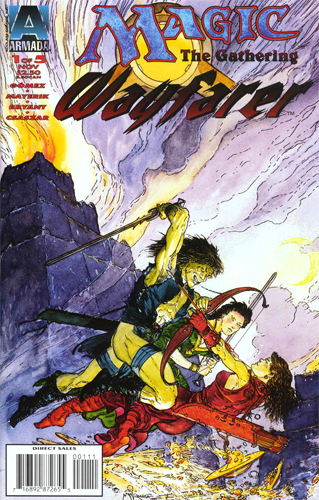
STORY SYNOPSIS
After defeating Ravidel, Jared Carthalion begins wandering the land of Corondor to learn more about the five colors of mana while a villainous shadow grows in the background.
CREATIVES
The Wayfarer creative team had a lot of overlap with the one that worked on Shadow Mage. Jeff Gomez once again wrote the entire series, while Val Mayerik provided the pencils. Rick Bryant did the inks. For issues 4 and 5, Bryant was assisted by Gonzalo Mayo, also of the Shadow Mage team.
Mark Csaszar (The Legend of Jedit Ojanen) served as colorist.


Michael Kaluta provided cover art for the entire series. Kaluta is a decorated comic book artist who has been working in the industry since the 1970s. Surprisingly, he has worked on relatively few superhero comics, instead gravitating toward pulp, horror, and original stories. He’s best known for his run on The Shadow and for illustrating and directing the Alan Parsons Project music video for the song “Don’t Answer Me.” A frequent contributor to music and book projects, Kaluta was named a Spectrum Award Grand Master in 2003.
Finally, each issue had a painted story section that corresponded to the five colors of mana. Dennis Calero (Fallen Angel) did the stories in issues 1 through 4. His avant-garde style from the time really lends itself to these metaphysical “stories within stories.” For some reason, Calero did not provide the mana story for issue 5, and Mayerik filled in.

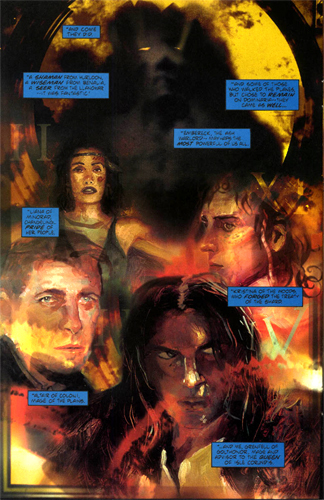
LORE
When Kristina transports herself and Jared to her home in the White Woods in issue 1, we learn that one of the lions in her menagerie is named Sandruu. This was, of course, the name of Kristina’s minotaur lover whom we met in Homelands and whom Taysir banished to some kind of prison realm during a fit of jealousy. Sandruu was likely to return in the unpublished Planeswalker War comic.
In issue 2, Kristina talks about missing Sandruu and Taysir, describing the latter as “that wise man I keep babbling about.” Is it possible Kristina is unaware that Taysir was the one who banished Sandruu to begin with because of Ravidel’s machinations?
In issue 3, Ravidel all but tells Liana that Taysir is his master. Taysir taking Ravidel as an apprentice is peculiar, as noted in the Homelands entry. In the back of issue 5, Jeof Vita writes, “Kudos to all of you who guessed that Taysir did indeed train Ravidel — and to those of you wondering how this could be, stay tuned!” Yet another question left unanswered by the series’ cancelation.
When is Jared’s birthday, and how old is he? Issue 1 of The Shadow Mage begins in the autumn of 1265. From the Battle of Aster Fall, it takes Jared and Ezer three months to get back to Arathoxia, and the season is described as “near the time of Yule.” Speaking to the Scarlet Vizier that same day, Ezer says, “This babe is the Master Jared — born nine months past.” If we take autumn of 1265 to mean September and Yuletide to mean December, it would mean that Jared was born approximately in March. However, issue 4 of Wayfarer takes place in autumn 1281 and opens with the line, “Earlier this evening, Kristina of the Woods wished Jared Carthalion a happy sixteenth birthday.” The year is correct — Jared would have turned 16 in 1281 — but his birthday should have occurred about six months earlier.
We know that pre-Mending Planeswalkers are long-lived. Grenfell Mor, Jared’s grandfather, is at least 1,300 years old at the time of this comic. One gets the sense that Jared’s mother, Gwendolyn, was also older than her apparent years, since it is said that she built the bridge city of Telemar.
Grenfell tells Jared that “your twisted ancestry has marauded through history since the time of the Blackblade.” The birth of the Carthalion line is, of course, recounted in the Dakkon Blackblade comic.
[EDIT 4/2/2018: We got confirmation that the Dakkon comic is still canon, thanks to episode one of the Dominaria story.]
Grenfell again mentions "the Treaty of the Shard," but there’s no indication as to what this means, especially since at this point in history The Shard is no longer in existence. (See also: Ice Age )
Ravidel refers to the Golgothian Sylex as the “Sylex of Argive,” and the Scarlet Vizier notes that it will “annihilate anything or anyone with a direct lineage to the time of the Brothers War.” While this is indeed what the card does in-game — namely, it destroys cards from the Antiquities expansion — this isn’t really what the sylex does in canon, where its effect is more like a nuclear blast on steroids. Shawn Carnes acknowledges the name change at the end of issue 5.
We also know that Ravidel somehow got the Golgothian Sylex from Ash Warlord Embereck shortly after the Ice Age ended, but the details of this event are shrouded in mystery.
In issue 5, we learn another scant detail about Ravidel’s home plane. We already know from the Summit at the Null Moon in Ice Age that Ravidel came from one of the 12 planes within The Shard. In issue 5 of Wayfarer, he says that the plane was destroyed when The Shard was formed. Presumably Ravidel was “dishonored … cast … out as a child” before this occurred.
Jared destroying the Golgothian Sylex in issue 5 is apparently canon.
Caliphear is definitely not killed during the events at the Dueling Chasm; she is merely unsummoned. Altair, however, likely perishes in the battle (a fact that Shawn Carnes confirms at the end of issue 5). Liana, meanwhile, is presumed to have died in the Abyss while stalling Ravidel in issue 3.
Daria, Taysir’s apprentice, is the first to arrive on Dominaria after the Mox Beacon is activated.
MISCELLANEOUS
Kadesha appears to have only four fingers on her right hand.

Hamath is said to have (or is in the process of making) an alliance with Avenant, which is described as an island north of Benalia. Avenant and Corondor are, literally, half a world away from each other so the purpose of this alliance is unclear, not to mention how long is must take for Avenant archers to travel to Corondor. We are, though, dealing with a world of magic, so anything is possible.
At one point, Elan says, “Today, Ravidel has finally played his wrong card.” I see what you did there, Jeff Gomez.
When Kristina interrupts the duel between Jared and Elan in issue 1, Kristina says, “Too much dried lobelia root, guys?” Lobelia root has never appeared on any MTG card, so we can only assume that it has some kind of intoxicating properties.
Kristina references the Order of Leitbur, which means she either traveled to or studied Sarpadia at one point.
In issue 4 of The Shadow Mage, the Grand Sultan states that there is a mysterious and powerful civilization hidden in the White Woods. In issue 2 of Wayfarer we learn that he was indeed referring to the Quirion Elves, which is divided into several tribes, namely the Calthyn and the Kieryn.
There seems to be a continuity error in issue 2. The transition panel on page 23 says, “Three days later,” but in the dialogue Jared says, “I told you yesterday … I’m not a bard.”
There’s a fun little Easter egg on page 25 of issue 2. When meeting Jared for the first time, the Force of Nature says, “Crescent of the dark … mark of the elder druid …” The crescent mark of the elder druids that Jared carries on his cheek is indeed the expansion symbol for The Dark set. Letter writers also point this out in the back of the same issue. Of course, the symbol also appeared in Ice Age and in a short story called “Feast of Kjeld” that appeared in Duelist issue 5. The always excellent Multiverse in Review has your back if you want to learn more about this story.
In the back of issue 2, the editors note that Ravidel’s planar barge is modeled after a War Barge.
One would think that the Trovash Engine that Jared and Kristina discover in issue 3 would have been printed on a physical card, possibly from the Antiquities set because it fits the flavor so well. However, this piece of Mishra-era mining equipment has never appeared on a physical MTG card.
During Grenfell’s tale, he says, “Something terrible had happened in Terisaire — to this day, the fate of that proud land is a mystery.” He also mentions that the council of Minorad drew on the scholarship of Taysir for knowledge. Since the third volume of the Urza-Mishra War comic was never produced — the comic “written” by Taysir which would have covered the events leading up to and including the sylex blast — it makes sense in the universe of the comics that the council of Minorad does not know how the war ended.
Grenfell Mor also utters the oath, “Sol’Kanar’s horns.”
The Scarlet Vizier appears at Ravidel’s side at the council at Minorad — meaning the Vizier is also more than 1,300 years old!
In issue 4, Ash Warlord Embereck says, “This place holds the key to my existence.” We’re not sure if he’s referring to Minorad or Dominaria as a whole, nor do we ever learn what he means.
In issue 5, Ravidel confirms that the Scarlet Vizier has perverse sexual appetites — as alluded to in The Shadow Mage
One of the monoliths in the Dueling Chasm of Golthonor is named Piru. Piru was Chromium (Rhuell)’s mate before she was killed by Dakkon Blackblade. In the comic Altair incorrectly calls her the “fabled fifth Elder Dragon.” She is actually the fabled sixth Elder Dragon, and her canonical status was confirmed in the first episode of the Dominaria story in 2018.
Caliphear is full of colorful curses. In issue 5, she says “Trine’s halo” — a nice reference to the Horned Halo and the fallen Serra Angel that wore it in ancient Corondor. See also the entry for the Fallen Angel comic.
Thus, we can only read the unreleased comic summary material that was made public nearly two decades after the fact and hope (fingers crossed) that Wizards of the Coast returns to the story someday. With the 25th anniversary expansion set on Dominaria, that hope is strong, albeit the chances are very small.
If you want to read fantastic summaries of the never-released Prelude to War and The Planeswalker War, in addition to the video game Battlemage, the excellent Multiverse in Review has you covered.
Wayfarer was published between November 1995 and March 1996.

STORY SYNOPSIS
After defeating Ravidel, Jared Carthalion begins wandering the land of Corondor to learn more about the five colors of mana while a villainous shadow grows in the background.
CREATIVES
The Wayfarer creative team had a lot of overlap with the one that worked on Shadow Mage. Jeff Gomez once again wrote the entire series, while Val Mayerik provided the pencils. Rick Bryant did the inks. For issues 4 and 5, Bryant was assisted by Gonzalo Mayo, also of the Shadow Mage team.
Mark Csaszar (The Legend of Jedit Ojanen) served as colorist.


Michael Kaluta provided cover art for the entire series. Kaluta is a decorated comic book artist who has been working in the industry since the 1970s. Surprisingly, he has worked on relatively few superhero comics, instead gravitating toward pulp, horror, and original stories. He’s best known for his run on The Shadow and for illustrating and directing the Alan Parsons Project music video for the song “Don’t Answer Me.” A frequent contributor to music and book projects, Kaluta was named a Spectrum Award Grand Master in 2003.
Finally, each issue had a painted story section that corresponded to the five colors of mana. Dennis Calero (Fallen Angel) did the stories in issues 1 through 4. His avant-garde style from the time really lends itself to these metaphysical “stories within stories.” For some reason, Calero did not provide the mana story for issue 5, and Mayerik filled in.


LORE
When Kristina transports herself and Jared to her home in the White Woods in issue 1, we learn that one of the lions in her menagerie is named Sandruu. This was, of course, the name of Kristina’s minotaur lover whom we met in Homelands and whom Taysir banished to some kind of prison realm during a fit of jealousy. Sandruu was likely to return in the unpublished Planeswalker War comic.
In issue 2, Kristina talks about missing Sandruu and Taysir, describing the latter as “that wise man I keep babbling about.” Is it possible Kristina is unaware that Taysir was the one who banished Sandruu to begin with because of Ravidel’s machinations?
In issue 3, Ravidel all but tells Liana that Taysir is his master. Taysir taking Ravidel as an apprentice is peculiar, as noted in the Homelands entry. In the back of issue 5, Jeof Vita writes, “Kudos to all of you who guessed that Taysir did indeed train Ravidel — and to those of you wondering how this could be, stay tuned!” Yet another question left unanswered by the series’ cancelation.
When is Jared’s birthday, and how old is he? Issue 1 of The Shadow Mage begins in the autumn of 1265. From the Battle of Aster Fall, it takes Jared and Ezer three months to get back to Arathoxia, and the season is described as “near the time of Yule.” Speaking to the Scarlet Vizier that same day, Ezer says, “This babe is the Master Jared — born nine months past.” If we take autumn of 1265 to mean September and Yuletide to mean December, it would mean that Jared was born approximately in March. However, issue 4 of Wayfarer takes place in autumn 1281 and opens with the line, “Earlier this evening, Kristina of the Woods wished Jared Carthalion a happy sixteenth birthday.” The year is correct — Jared would have turned 16 in 1281 — but his birthday should have occurred about six months earlier.
We know that pre-Mending Planeswalkers are long-lived. Grenfell Mor, Jared’s grandfather, is at least 1,300 years old at the time of this comic. One gets the sense that Jared’s mother, Gwendolyn, was also older than her apparent years, since it is said that she built the bridge city of Telemar.
Grenfell tells Jared that “your twisted ancestry has marauded through history since the time of the Blackblade.” The birth of the Carthalion line is, of course, recounted in the Dakkon Blackblade comic.
[EDIT 4/2/2018: We got confirmation that the Dakkon comic is still canon, thanks to episode one of the Dominaria story.]
Grenfell again mentions "the Treaty of the Shard," but there’s no indication as to what this means, especially since at this point in history The Shard is no longer in existence. (See also: Ice Age )
Ravidel refers to the Golgothian Sylex as the “Sylex of Argive,” and the Scarlet Vizier notes that it will “annihilate anything or anyone with a direct lineage to the time of the Brothers War.” While this is indeed what the card does in-game — namely, it destroys cards from the Antiquities expansion — this isn’t really what the sylex does in canon, where its effect is more like a nuclear blast on steroids. Shawn Carnes acknowledges the name change at the end of issue 5.
We also know that Ravidel somehow got the Golgothian Sylex from Ash Warlord Embereck shortly after the Ice Age ended, but the details of this event are shrouded in mystery.
In issue 5, we learn another scant detail about Ravidel’s home plane. We already know from the Summit at the Null Moon in Ice Age that Ravidel came from one of the 12 planes within The Shard. In issue 5 of Wayfarer, he says that the plane was destroyed when The Shard was formed. Presumably Ravidel was “dishonored … cast … out as a child” before this occurred.
Jared destroying the Golgothian Sylex in issue 5 is apparently canon.
Caliphear is definitely not killed during the events at the Dueling Chasm; she is merely unsummoned. Altair, however, likely perishes in the battle (a fact that Shawn Carnes confirms at the end of issue 5). Liana, meanwhile, is presumed to have died in the Abyss while stalling Ravidel in issue 3.
Daria, Taysir’s apprentice, is the first to arrive on Dominaria after the Mox Beacon is activated.
MISCELLANEOUS
Kadesha appears to have only four fingers on her right hand.

Hamath is said to have (or is in the process of making) an alliance with Avenant, which is described as an island north of Benalia. Avenant and Corondor are, literally, half a world away from each other so the purpose of this alliance is unclear, not to mention how long is must take for Avenant archers to travel to Corondor. We are, though, dealing with a world of magic, so anything is possible.
At one point, Elan says, “Today, Ravidel has finally played his wrong card.” I see what you did there, Jeff Gomez.
When Kristina interrupts the duel between Jared and Elan in issue 1, Kristina says, “Too much dried lobelia root, guys?” Lobelia root has never appeared on any MTG card, so we can only assume that it has some kind of intoxicating properties.
Kristina references the Order of Leitbur, which means she either traveled to or studied Sarpadia at one point.
In issue 4 of The Shadow Mage, the Grand Sultan states that there is a mysterious and powerful civilization hidden in the White Woods. In issue 2 of Wayfarer we learn that he was indeed referring to the Quirion Elves, which is divided into several tribes, namely the Calthyn and the Kieryn.
There seems to be a continuity error in issue 2. The transition panel on page 23 says, “Three days later,” but in the dialogue Jared says, “I told you yesterday … I’m not a bard.”
There’s a fun little Easter egg on page 25 of issue 2. When meeting Jared for the first time, the Force of Nature says, “Crescent of the dark … mark of the elder druid …” The crescent mark of the elder druids that Jared carries on his cheek is indeed the expansion symbol for The Dark set. Letter writers also point this out in the back of the same issue. Of course, the symbol also appeared in Ice Age and in a short story called “Feast of Kjeld” that appeared in Duelist issue 5. The always excellent Multiverse in Review has your back if you want to learn more about this story.
In the back of issue 2, the editors note that Ravidel’s planar barge is modeled after a War Barge.
One would think that the Trovash Engine that Jared and Kristina discover in issue 3 would have been printed on a physical card, possibly from the Antiquities set because it fits the flavor so well. However, this piece of Mishra-era mining equipment has never appeared on a physical MTG card.
During Grenfell’s tale, he says, “Something terrible had happened in Terisaire — to this day, the fate of that proud land is a mystery.” He also mentions that the council of Minorad drew on the scholarship of Taysir for knowledge. Since the third volume of the Urza-Mishra War comic was never produced — the comic “written” by Taysir which would have covered the events leading up to and including the sylex blast — it makes sense in the universe of the comics that the council of Minorad does not know how the war ended.
Grenfell Mor also utters the oath, “Sol’Kanar’s horns.”
The Scarlet Vizier appears at Ravidel’s side at the council at Minorad — meaning the Vizier is also more than 1,300 years old!
In issue 4, Ash Warlord Embereck says, “This place holds the key to my existence.” We’re not sure if he’s referring to Minorad or Dominaria as a whole, nor do we ever learn what he means.
In issue 5, Ravidel confirms that the Scarlet Vizier has perverse sexual appetites — as alluded to in The Shadow Mage
One of the monoliths in the Dueling Chasm of Golthonor is named Piru. Piru was Chromium (Rhuell)’s mate before she was killed by Dakkon Blackblade. In the comic Altair incorrectly calls her the “fabled fifth Elder Dragon.” She is actually the fabled sixth Elder Dragon, and her canonical status was confirmed in the first episode of the Dominaria story in 2018.
Caliphear is full of colorful curses. In issue 5, she says “Trine’s halo” — a nice reference to the Horned Halo and the fallen Serra Angel that wore it in ancient Corondor. See also the entry for the Fallen Angel comic.
Published on April 02, 2018 18:53
•
Tags:
comic-books, comics, magic-the-gathering, mtg, wizards-of-the-coast, wotc



